Pam Hawley Marlin April 2021
Author's note: A special thank you to the Bonaventure Historical Society for providing the "Marked Sculptures by various sculptors in Bonaventure Cemetery" list from which I gathered the Bonaventure sculpture information. 9
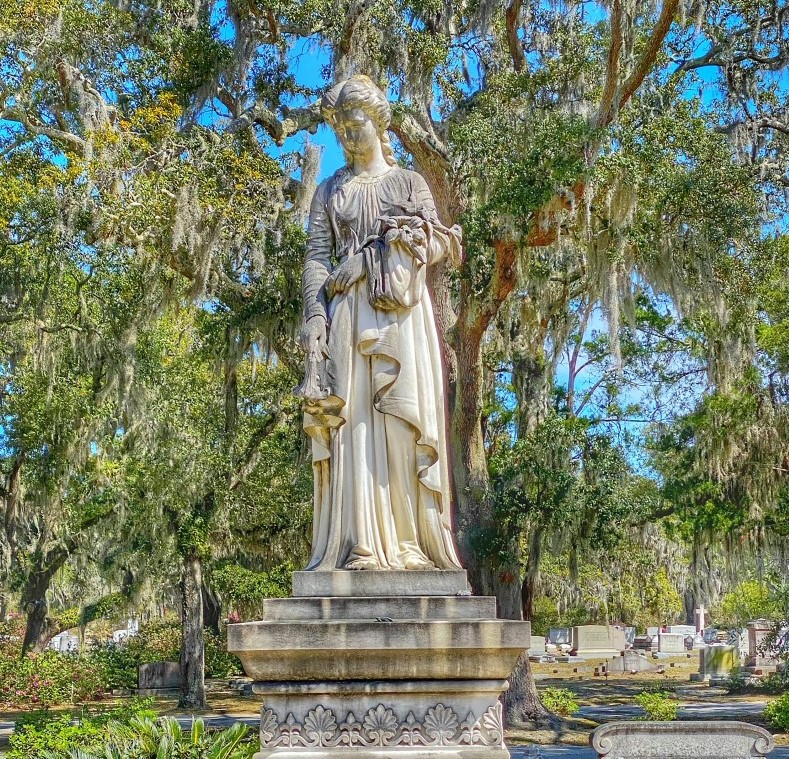 The Gertrude A. Bliss McMillan monument in Bonaventure Cemetery. This sculpture was created by John Walz. P Marlin 2021
The Gertrude A. Bliss McMillan monument in Bonaventure Cemetery. This sculpture was created by John Walz. P Marlin 2021
Before it was a cemetery, Bonaventure was the site of an 18th century plantation and Revolutionary War activities. In 1760, an Englishman named Colonel John Mullryne arrived in Savannah as recipient of a Christ Church Parish land grant from King George of England. It was on this land, located along the Wilmington River, that Mullryne built a mansion of bricks imported from England. He called the place "Bonaventure" after the French word, "Buena Ventura" meaning "good fortune." There were no crops on this plantation, however, Myllryne directed the planting of live oak trees every fifteen feet along both sides of the main avenue. Mullryne’s trees were established on what is today Mullryne Way and Bonaventure Way in Bonaventure Cemetery. In the 1779 map of Bonaventure below, the live oaks are lining the avenue. 1, 2, 3
At the outbreak of the Revolutionary War in 1775, John Mullryne and his son-in-law, Josiah Tattnall, declared their loyalty to King George III of England. In 1776, the Royal Governor of Georgia (the last royal governor of Georgia), Sir James Wright, was arrested and imprisoned by the "Rebels" (those in favor of independence from Britain). After Wright managed to break free of his confinement, Mullryne and Tattnall further aided the Governor's escape by whisking him, under cover of darkness, through Bonaventure to a nearby British ship, the HMS Scarborough. Afterwards, the Mullryne and Tattnall families fled Georgia. After their departure, Bonaventure Plantation was confiscated and sold at auction to John Habersham. 3, 4
 A map of the Siege of Savannah, from the "Journal du siege de
Savannah, Observations of Comte d'Estaing," reveal trees lining
the avenue that leads to the plantation, as well as other paths. The hospital and
Thunder Bolt Bluff was the original Bonaventure Plantation site.
Internet Archive
A map of the Siege of Savannah, from the "Journal du siege de
Savannah, Observations of Comte d'Estaing," reveal trees lining
the avenue that leads to the plantation, as well as other paths. The hospital and
Thunder Bolt Bluff was the original Bonaventure Plantation site.
Internet Archive
The 1779 Siege of Savannah became one of the costliest battles of the Revolutionary War in terms of casualties. Bonaventure was the site where French troops, under Comte Charles d'Estaing, established their hospital camp after an attempt to regain Savannah from British control. As the French, along with American militia, were tragically defeated by the British, more than 300 soldiers were killed and as many wounded. The injured were transported from the site of the battle, on the west side of Savannah, to Bonaventure. Many French and Haitian soldiers died at Bonaventure and are thought to be buried in unknown graves. During this course of events, Bonaventure plantation was pillaged and damaged, and then, after 1800, caught fire. Years later, digging in the older section of the cemetery revealed burnt debris and old bricks suggesting that the original Bonaventure Plantation house was originally located in Section F of Bonaventure Cemetery. 1
At the end of the Revolutionary War, Bonaventure was returned to the Tattnall family when Josiah Tattnall’s son, Josiah Tattnall Jr., returned to Georgia to fight in the Continental Army. A future senator and governor, Josiah Tattnall Jr. purchased Bonaventure Plantation back from John Habersham in 1785. Harriett Tattnall, the wife of Josiah Jr., died in 1802 and was the first adult buried at Bonaventure. She rests alongside her four children who died in infancy (photo of the table monument below). Josiah Tattnall Jr. died the next year in 1803 and is also buried near his wife.
A member of the third generation of Tattnall's, Josiah Tattnall III (there are three generations of Josiah Tattnall's), inherited Bonaventure Plantation. A captain during the Civil War and then commodore, Tattnall did not spend much time at Bonaventure and desired to sell the land for public use. The excerpt below from the Savannah Daily Republic August 23, 1945, mentions that Jos. Cummings acted on behalf of Josiah Tattnall III in stating that "Conversation with many citizens has led me to the present measure of offering Bonaventure to the Board of Alderman as a desirable site for a public cemetery. There, internments can be made far from the city. The dead would repose under the shade of the oaks of the soil."
In 1846, Josiah Tattnall III sold 600 acres of Bonaventure to Peter Wiltburger, the owner of the local Pulaski Hotel. Wiltberger continued with the purpose of turning a portion of Bonaventure into a cemetery, and soon the Evergreen Cemetery Company was established to operate the cemetery at Bonaventure. The cemetery was privately owned but open to public use. James Rion, a young son of an employee at the Pulaski Hotel, was hired by Wiltberger to design the cemetery in the Victorian style with curving pathways and trees. Rion wrote of Bonaventure, "Long rows of venerable oaks meet the eye on every side...forming extensive avenues... The hand of man has done this much in planting these living colonnades... richly festooned...with a magnificent drapery of moss which hangs in all possible forms." Rion also notes that by 1849 some burials were taking place in Bonaventure when he observed "From what I observed around, active preparations are going on to fit this place for a cemetery. At the end of one of the avenues, I saw a neat monument, recently erected." 1
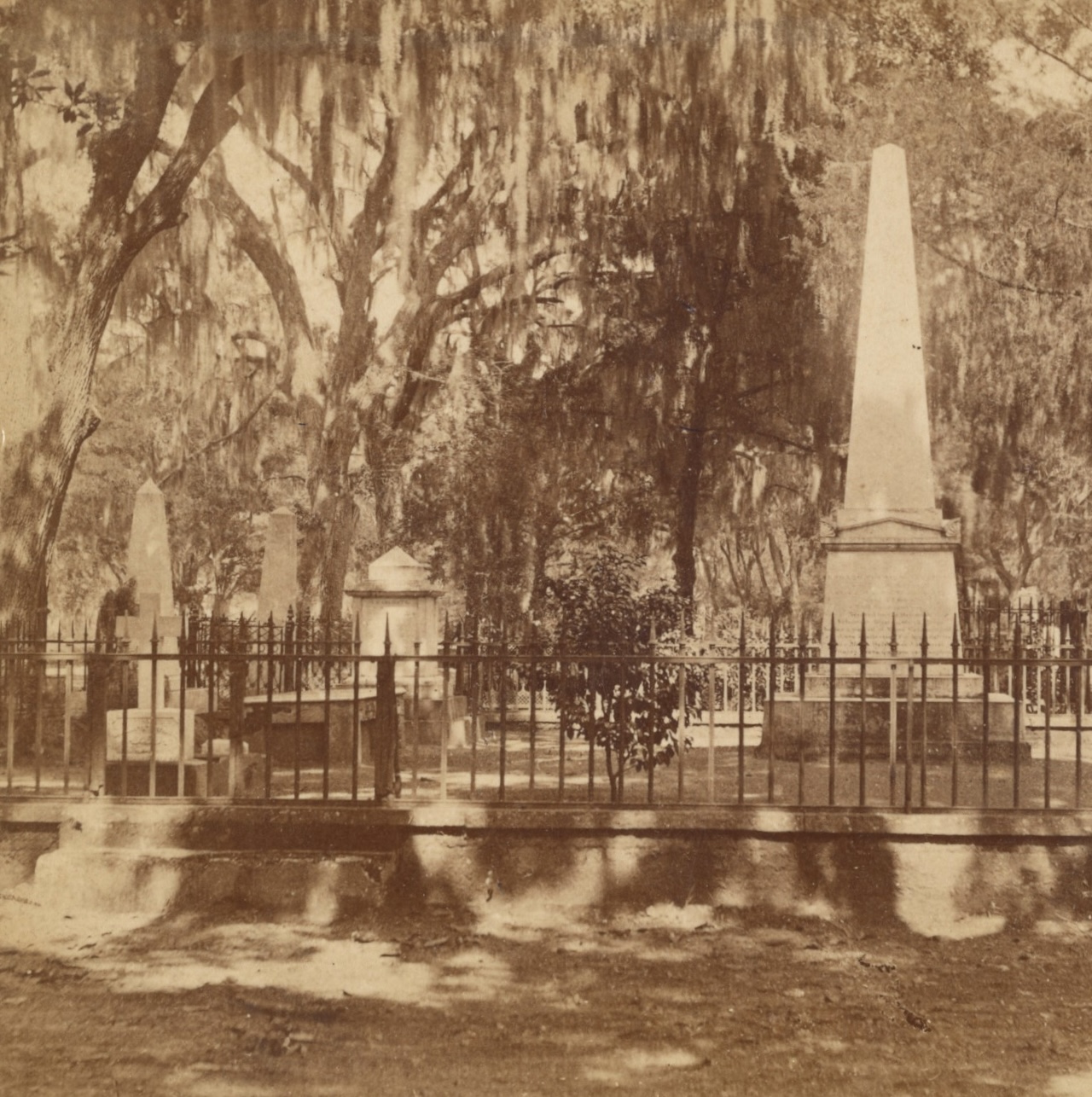 The Tattnall family plot. 1874 J. Paul Getty Museum
The Tattnall family plot. 1874 J. Paul Getty Museum
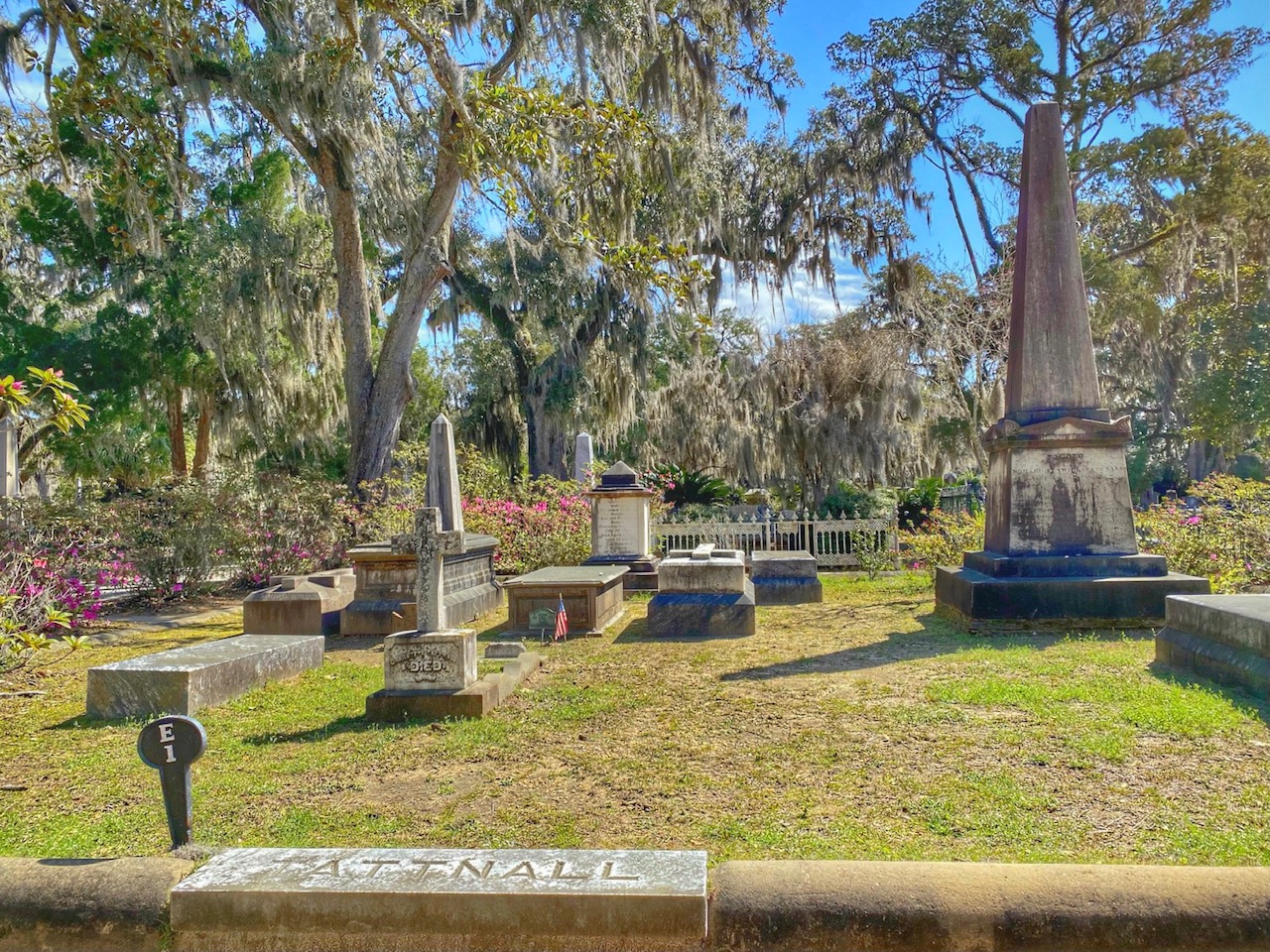 The Tattnall family plot in 2021 with the iron gate removed. P Marlin
The Tattnall family plot in 2021 with the iron gate removed. P Marlin
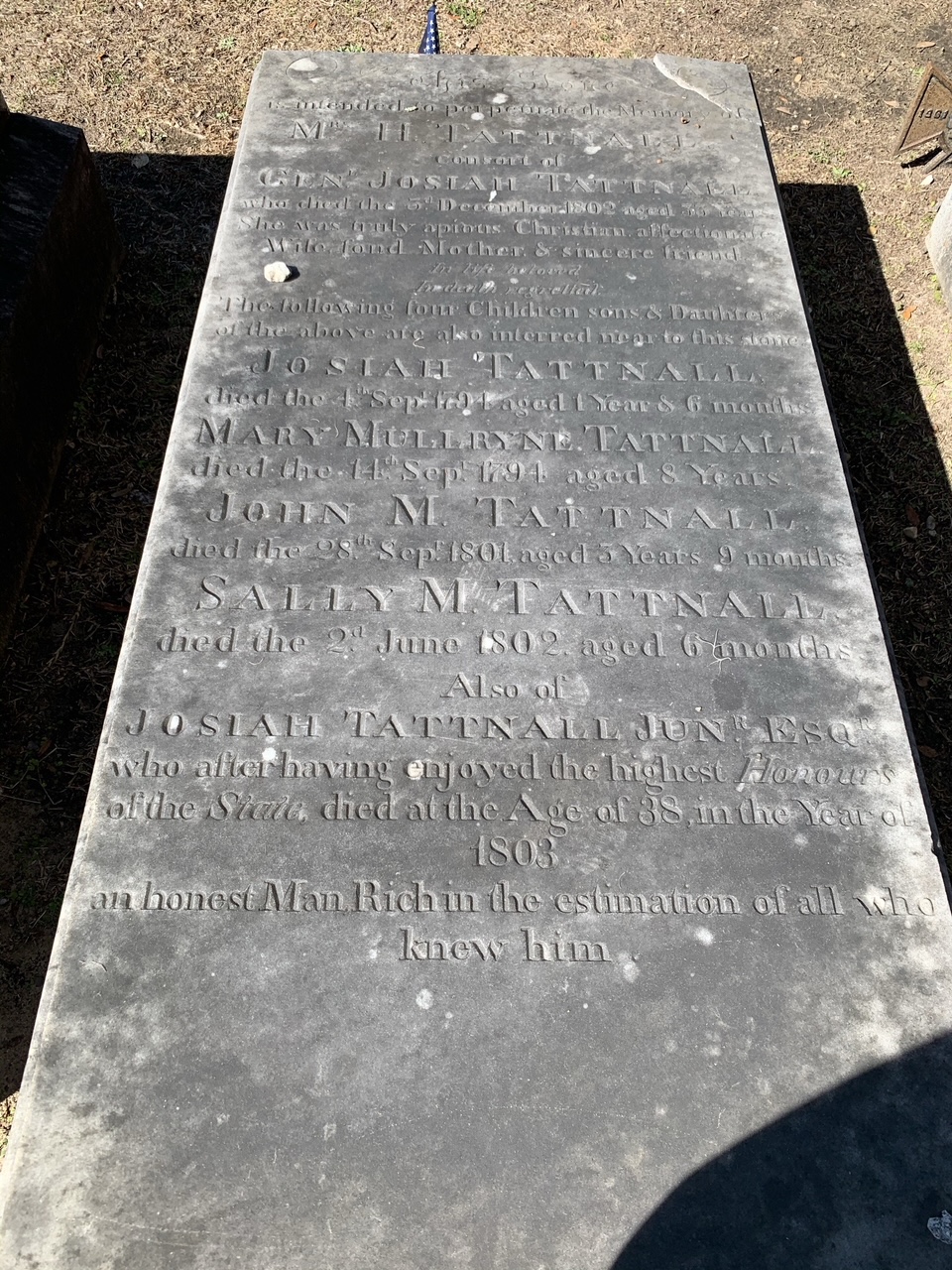 The tomb of Harriett Tattnall, the first adult buried
at Bonaventure, alongside her children who died in infancy. Robert
Allen of Savannah was the sculptor. 9 P Marlin 2021
The tomb of Harriett Tattnall, the first adult buried
at Bonaventure, alongside her children who died in infancy. Robert
Allen of Savannah was the sculptor. 9 P Marlin 2021
Burials at Bonaventure did not increase until cemetery overcrowding became a problem and rural cemeteries became popular. Families purchased large plots at the cemetery and then had their loved ones moved to Bonaventure from other cemeteries. The Geiger-Cook family was one of the first plots purchased in Bonaventure. The cemetery doubled in size and was made available for public burials when the City of Savannah purchased Bonaventure in 1907. This purchase had been discussed for over a decade.
 According the cemetery tour, Geiger-Cook
was the first plot sold at the newly established cemetery. P Marlin 2021
According the cemetery tour, Geiger-Cook
was the first plot sold at the newly established cemetery. P Marlin 2021
As the live oak trees planted by John Mullryne in 1764 matured into the mid 19th century, they created a dense canopy over the unpaved avenues and foot paths. These canopied views inspired visitors to share their experience as Bonaventure was featured in poems, travel articles, short stories, and novels, all of which were circulated in literary magazines, tourist guidebooks, and newspapers. 5
A poem by Henry Rootes Jackson published in a Southern magazine in 1842, titled, “Bonaventure, by Starlight” begins,
Along a corridor I tread,
High over-arched by ancient trees,
There, like a tapestry o'erhead,
The gray moss floats upon the breeze;...
The literary features increased Bonnaventure's tourism. Notable visitors such as Millard Fillmore, Ulysses S. Grant, William McKinley, and Harriet Beecher Stowe experienced Bonaventure's beauty. In 1869, John Muir, the naturalist, visited Bonaventure on his walk from Indianapolis to Florida. Finding himself without funds, Muir camped amongst the tombstones for a week and wrote about nature and death as he observed his surroundings. "Only a small plot of ground is occupied with graves, and the old mansion in the ruins. The most open glory of Bonaventure is its noble avenue of live oaks, but planted in grand avenues there are thousands of smaller trees and clustered bushes covered almost from sight in the brightness of their own light." 4, 5, 6
 Thomas Addison Richards (American, b. England, 1820–1900),
Entrance to Bonaventure Cemetery and Bonaventure, from Harper’s
Weekly, December 1, 1860, engraving on paper.
Telfair Museums
Thomas Addison Richards (American, b. England, 1820–1900),
Entrance to Bonaventure Cemetery and Bonaventure, from Harper’s
Weekly, December 1, 1860, engraving on paper.
Telfair Museums
A century before the cemetery at Bonaventure was established, people did not visit cemeteries due to fear of pestilence or the unpleasantness associated with visiting the dead. In the 19th century, however, the Victorian Era ushered in romantic ideals about death and cemeteries were no longer a place of sadness, "Cemeteries began to look like parks and became a place of rest for the dead as well as a place of relaxation for the living. Bonaventure became a city of the dead, rather than just a place of burial." 7
 "Although a cemetery, it was
common for families to meet and picnic here while still
providing a place of comfort and solace for the bereaved friends and
relatives of those buried there." 3 The Bonaventure
Historical Society.
"Although a cemetery, it was
common for families to meet and picnic here while still
providing a place of comfort and solace for the bereaved friends and
relatives of those buried there." 3 The Bonaventure
Historical Society.
A century and a half has passed since Bonaventure became a cemetery, and the lush landscape that attracted visitors in the 19th century continues to thrive and impress visitors today. In addition to the live oaks, additional flora include azaleas, camellias, dogwood, magnolia trees, cedar, pine, and palmetto trees. The Bonaventure live oaks were added to the Georgia Tree Council's Landmark and Historic Tree Register in 2004. According to the Register, "The trees survived two local wars and five major hurricanes, not to mention lesser hurricanes and tropical storms, too numerous to count. Approximately one-third of the original trees remain. The trees have changed little since the 1870s except due to decline or death of individual trees." 11 New oaks were planted in 1898. The following photos offer a historical perspective of Bonaventure's landscape from over a century ago to today.
There are two gateways that provide access to the cemetery. The gateway pictured below was built prior to 1908 and consists of two stone pillars. These pillars form a base for the statue of Mary and of the Cross (represents faith and grief). The iron gate attached to these pillars is said to be from the plantation era. The second gateway, located on the other side of the historic brick caretaker's house, has two pillars topped with the Star of David. This entrance leads to the Jewish section of the cemetery.
 The Road to Bonaventure 1870. New York Public Library
The Road to Bonaventure 1870. New York Public Library
 The Road to Bonaventure 2021.
The Road to Bonaventure 2021.
 Bonaventure Cemetery entrance with the concrete pillars topped by Mary and the cross. 1870. New York Public Library
Bonaventure Cemetery entrance with the concrete pillars topped by Mary and the cross. 1870. New York Public Library
 According to the
Bonaventure cemetery tour guide, the iron gates now attached to the concrete pillars were the original iron gates to Bonaventure when it was a plantation.
P Marlin 2021
According to the
Bonaventure cemetery tour guide, the iron gates now attached to the concrete pillars were the original iron gates to Bonaventure when it was a plantation.
P Marlin 2021
Duncan Lamont Clinch, a US Army officer, became a brigadier general in 1829. He commanded at the Battle of Ouithlacoochee against the Seminoles in 1835. In 1844 he was elected to fill the vacancy as a US Representative; he served until 1845.
 General Clinch Tomb 1860-1890. New York Public Library
General Clinch Tomb 1860-1890. New York Public Library
 General Clinch tomb in 2021. P Marlin
General Clinch tomb in 2021. P Marlin
The Stubbs family monument. This monument was sculpted by W.F. Pietch of New York. 9
 The Stubbs family monument.1862-1963 New York Public Library
The Stubbs family monument.1862-1963 New York Public Library
 The Stubbs family monument in 2021. P Marlin
The Stubbs family monument in 2021. P Marlin
Robert Houston Anderson was a West Point graduate and Civil War Confederate Brigadier General. After the war, Anderson returned to Savannah and was that city's chief of police from 1867 until his death.
 The Robert Houston Anderson monument with bust on the left in 1901.
Library of Congress
The Robert Houston Anderson monument with bust on the left in 1901.
Library of Congress
 Robert Houston Anderson monument with bust on the left in 2021.
This photo was taken closer than the photo above. Notice the concrete coping
at the forefront. P Marlin
Robert Houston Anderson monument with bust on the left in 2021.
This photo was taken closer than the photo above. Notice the concrete coping
at the forefront. P Marlin
Near the turn of the 20th century, the Stoddard family had the John David Mongin mausoleum moved from Daufuskie Island to Bonaventure. The mausoleum sits close to the river because its weight, after floating down the river by barge, prevented it from being placed further inland. The mausoleum is in the Egyptian Revival Pyramidal style. According to the cemetery tour guide, this mausoleum is empty because the bones have mysteriously disappeared. Mongin Family History
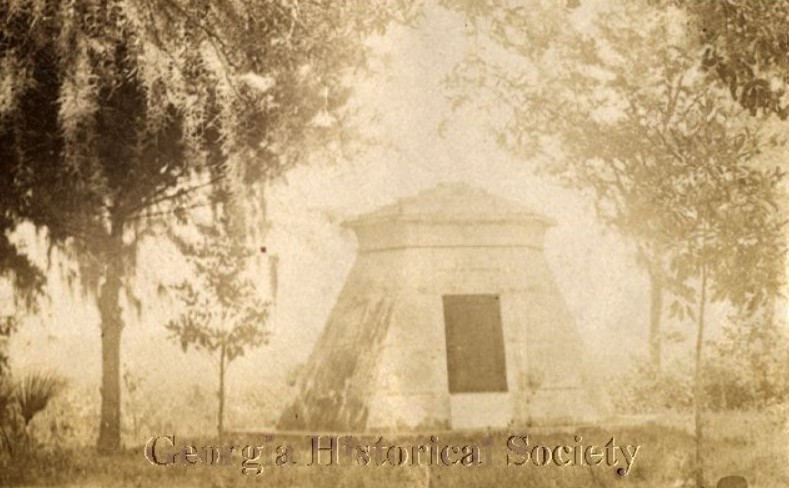 Mongin family tomb 1888-1900. Georgia Historical Society
Mongin family tomb 1888-1900. Georgia Historical Society
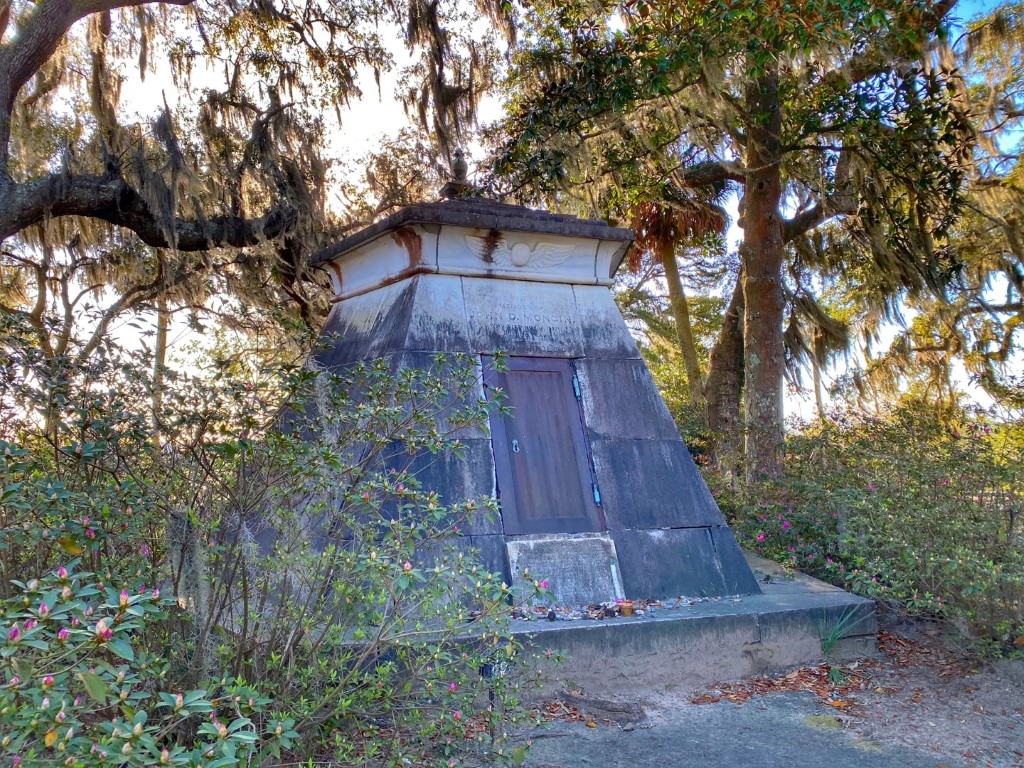 Mongin family tomb. P Marlin 2021
Mongin family tomb. P Marlin 2021
The tomb of Noble Wymberly Jones (of the Wormsloe Plantation Noble Jones family) and his son, George Jones. Noble Wymberly Jones was referred to as the "Morning Star of Liberty," due to his prominence among Georgia's Whig leaders before and during the American Revolution. Noble Jones was also educated in medicine and was a physician in Savannah (died 1805). His son, George, was a US Senator. Some members of the Jones family were originally buried at Colonial Park Cemetery but were re-interred at Bonaventure in May 1880 by Noble's grandson, George Wymberly Jones DeRenne. In all, nine family members were moved.
 Jones tomb in the distance. Georgia Historical Society.
Jones tomb in the distance. Georgia Historical Society.
 Jones tomb located in the middle of the photo in 2021. P Marlin
Jones tomb located in the middle of the photo in 2021. P Marlin
The Edward and Elizabeth Padelford Monument. Edward Padelford was a prominent merchant who arrived in Savannah around 1820 from Massachusetts. He was a founder of the St. John's Episcopal Church. The Padelford monument was sculpted by Struthers & Co., Philadelphia. 9
 Padelford monument. 1856-1908. New York Public Library
Padelford monument. 1856-1908. New York Public Library
 Padelford monument. P Marlin 2021
Padelford monument. P Marlin 2021
The Corinne Elliot Lawton sculpture. Interestingly, the caption of this photo at the New York Public Library indicates it was taken at Bonventure Cemetery, however, the photo was taken at Laurel Grove Cemetery where Corinne was originally interred. Corinne and her father were both interred at Laurel Grove Cemetery then re-interred at Bonaventure Cemetery in 1898. Corinne died in 1877. Her monument was sculpted by Civiletti (Palermo). 9
 Corinne Lawton at Laurel Grove Cemetery. 1856-1908.
New York Public Library
Corinne Lawton at Laurel Grove Cemetery. 1856-1908.
New York Public Library
 Corinne Lawton at Bonaventure Cemetery. P Marlin 2021
Corinne Lawton at Bonaventure Cemetery. P Marlin 2021
Funerary art is described as a work of art placed or forming a part of a burial site for decoration. These art pieces are typically the work of artisans. As a cultural practice that dates back to ancient times, burial monuments celebrate and memorialize the dead. Funeral art was mostly reserved for the wealthy, however, even burials of ordinary people may have included funerary art pieces coming from their possessions.
Bonaventure Cemetery is significant in funerary art because of its numerous burial monuments from different eras and architectural styles. The funerary architecture, including mausoleums, crypts, tablets, obelisks, and statuary cover the ground below the large oak trees. Classic Roman, Greek, Egyptian, and High Victorian Gothic were common styles used in decoration. In the Victorian Era, the cherubs, angels, animals, columns, flora, and crosses carved into granite or marble would lend themselves to symbolic meanings. Low marble coping stones or decorative cast iron fences bordered large family plots adding definition. "Many of Bonaventure’s graves date to the Victorian Era and are decorated with iconography that was typically depicted on headstones during the era. The symbolism on the headstones each represent something different, and were chosen because they were considered meaningful by the deceased and their family." 1, 7
Bonaventure Cemetery's funerary art includes a significant number of works by sculptor John Walz as well as sculptors from New York, Philadelphia, and Italy. As seen in the photos below, the sculptor's name can be seen on many of the monuments in Bonaventure.
Sculptor John Walz was born in Wuttenberg, Germany in 1844. As a teenager, he moved to Philadelphia, Pennsylvania to live with his sister. In the 1860 Philadelphia census, Walz was sixteen years old and working as a stone cutter. To pursue a career as a sculptor, Walz returned to Europe and worked with Professor Victor Tilgner of the Austrian Royal Academy of Fine Arts. It was during this time that Walz, also a linguist, served at the Austrian Court as interpretor to the French commissary general and the French minister.10 Walz became preeminent sculptor in Savannah from the 1890s until his death in 1922.
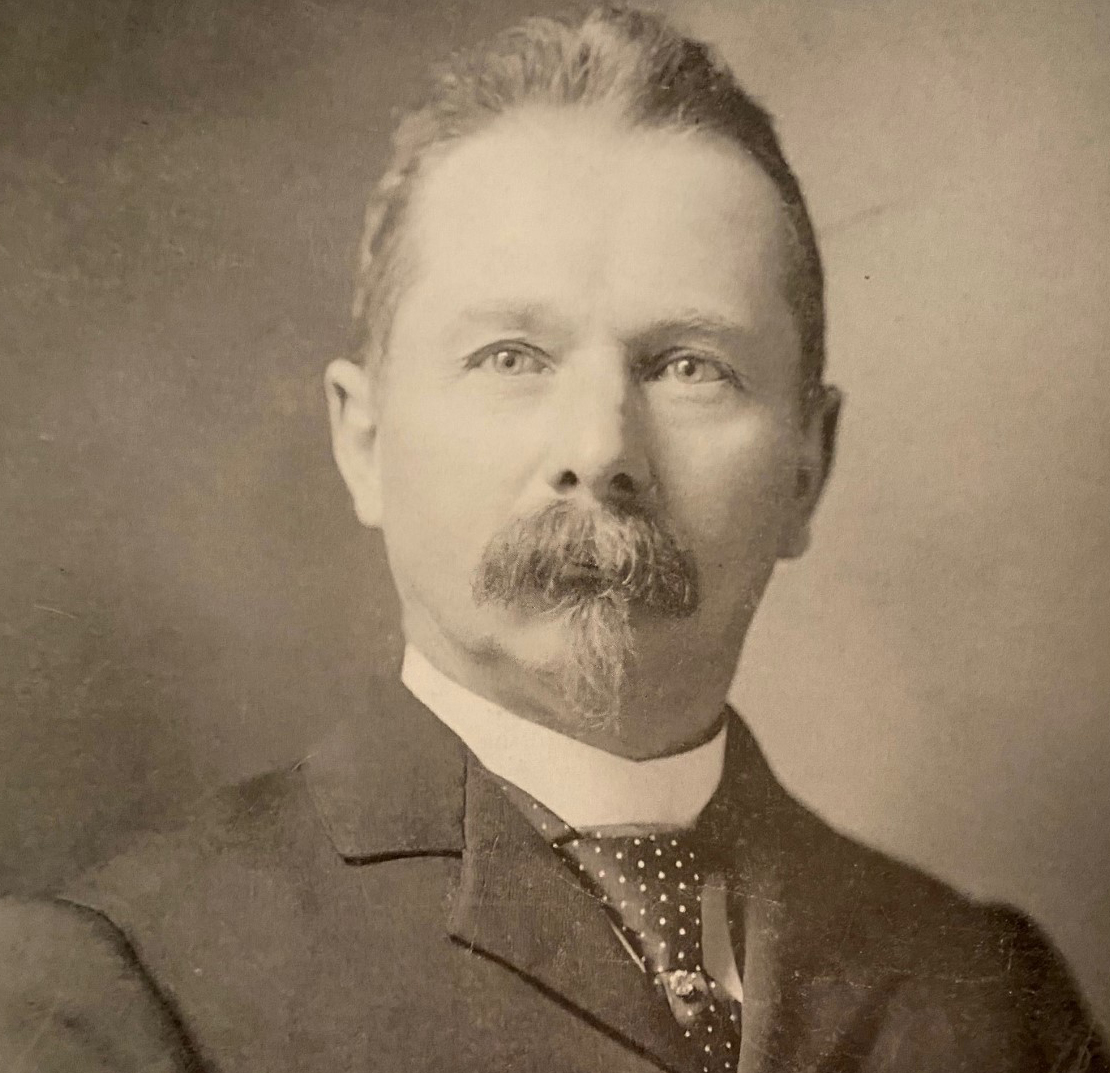 Sculptor John Walz. Georgia Historical Society
Sculptor John Walz. Georgia Historical Society
Walz's journey to Savannah began in 1883 when Carl Brandt, the first director of Savannah's new art museum, Telfair Academy of Arts and Sciences, commissioned Walz's mentor, Professor Victor Tilgner, to create five stone statues for the Telfair Academy. The statues created were of Phidias, Raphael, Rembrandt, Rubens and Michael Angelo. The first two statues arrived in Savannah by boat in 1884, with the final three statues arriving in October 1885. It is said that Walz accompanied the statues to Savannah and after his arrival, decided to spend more time in the city. The five statues were in place for the opening of the Telfair Academy of Arts and Sciences on May 3, 1886.
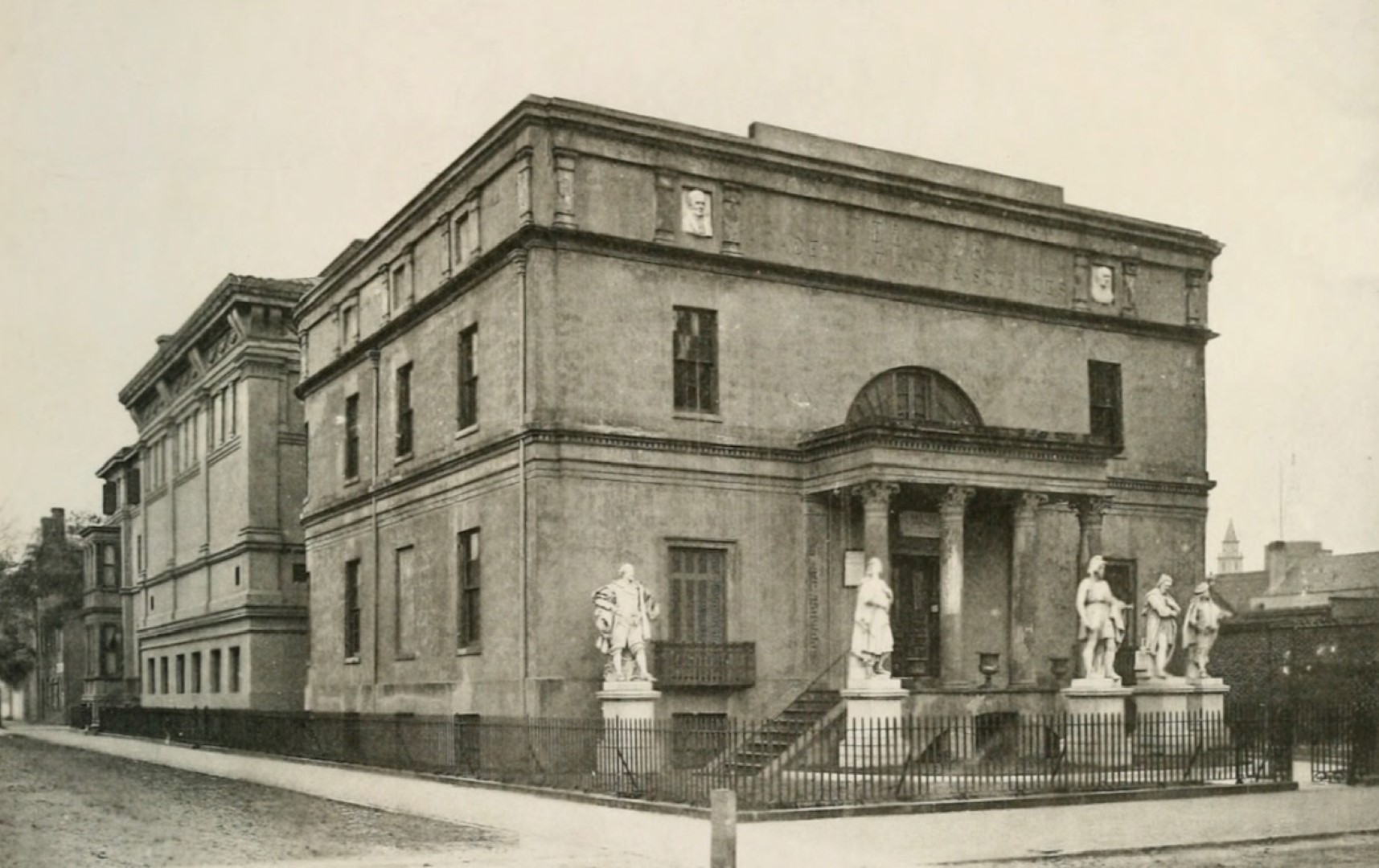 Telfair Academy of Sciences.
Telfair Academy of Sciences.
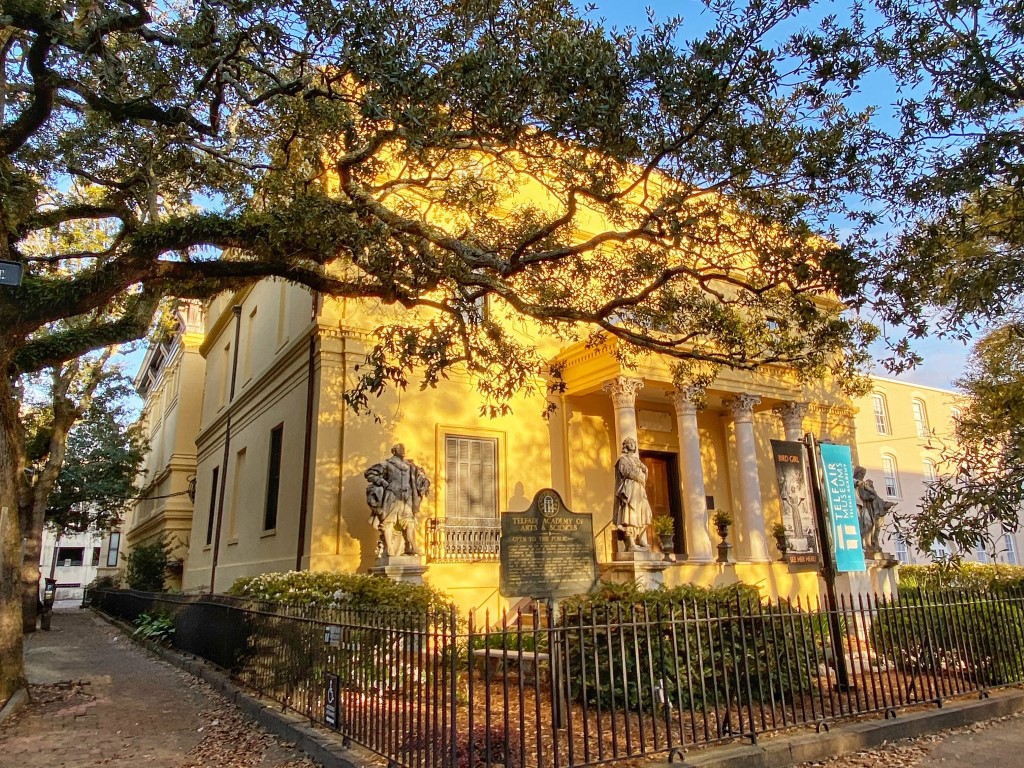 Telfair Academy of Sciences in 2021. P Marlin
Telfair Academy of Sciences in 2021. P Marlin
 An 1892 issue of The Monumental News mentions
that Walz is spending his winters in Savannah. The Monumental
News 1892 Page 222
An 1892 issue of The Monumental News mentions
that Walz is spending his winters in Savannah. The Monumental
News 1892 Page 222
An 1895 article from The Morning News titled " Bust of Bismarck," featured Walz as he prepared sculptures for the 1895 Cotton States and International Exposition in Atlanta. "Down on Broughton street, between Montgomery and West Broad, there is a small office building painted white. This little room is the studio of Mr. John Walz, sculptor and artist. It would never be taken for a home of art, yet inside there is now being developed under the master's hand, a colossal bust of Germany's ex-chancellor, Prince Bismarck." In addition to the Exposition, Walz created the Bismarck Bust in honor of the Prince's 80th birthday. This event was celebrated with patriotic fervor by Walz and his fellow Germans at Turner Hall in Thunderbolt where the Bismarck Bust was exhibited. The event is described in an article from The Morning News " In Honor of the Iron Prince." The Bismarck Bust made another appearance at the Church of the Ascension during a memorial service for Bismarck upon the Prince's death in 1898. The bust survived until World War I when Savannah citizens insisted that Walz destroy the bust, which he did.
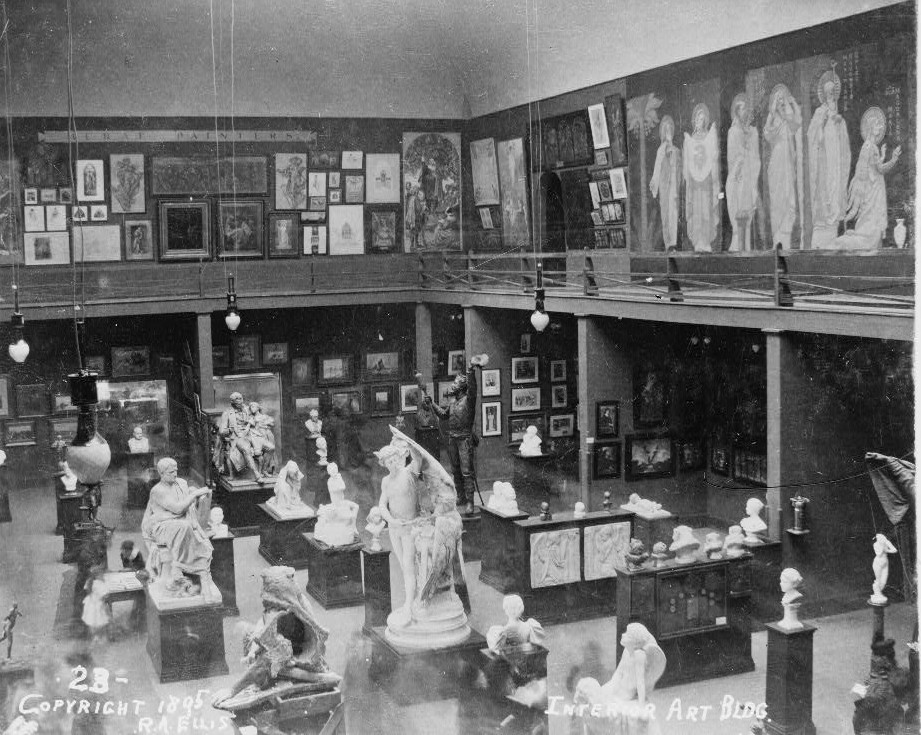 The interior of the Fine Arts building at the Cotton States and
International Exposition in Atlanta. Does anyone see a bust of Prince Bismarck?
Library of Congress
The interior of the Fine Arts building at the Cotton States and
International Exposition in Atlanta. Does anyone see a bust of Prince Bismarck?
Library of Congress
The following addresses are locations in the City of Savannah where Walz lived or had a stone cutting/sculpting studio. In addition to Bonaventure's funerary sculptures, Walz was commissioned to work on prominent buildings in Savannah. This work can be seen on the carvings on the Masonic Temple on Bull Street, the figures over the entrance of Chatham Academy on Oglethorpe Avenue, designs on the Wright Square Post Office, and the baptismal font at St. Paul's Lutheran Church. Of the many works by Walz in Bonaventure Cemetery, his sculpture of the little girl, Gracie Watson, is most famous. As visitors continue to seek out her resting place in Bonaventure, Walz is credited with keeping Gracie's memory alive through her exquisitely carved likeness.
The 1895, the "Bismarck Bust" article mentions that Walz was working on West Broughton Street, "Down on Broughton street, between Montgomery and West Broad [renamed Martin Luther King today]." Without a street number, it is difficult to find the location of his studio, however, three years later, in 1898, Walz is listed as a boarder at 408 West Broughton Street. This location is on the same section of street as the studio mentioned in the article.
City of Savannah Directories list Walz at the following addresses:
1898 - boarder at 408 West Broughton Street
1899 - 410 Bull Street, listed as sculptor
1902 and 1903 - boarder at 507 East Broughton Street
1905 through 1907 - boarding at 507 East Broughton Street and sculptor at 407-411 East Liberty Street
1908 through 1911 - living at 303 Price Street and sculptor and stone yard at 407-411 East Liberty Street
1912 through 1922 - living and sculptor at 407 - 409 East Liberty street
Walz is listed as a boarder at 408 West Broughton street in 1898. Did he also have a studio nearby? Walz was commissioned to sculpt the Gracie Watson statue in 1890, the year after she died. I wonder where his studio was located then.
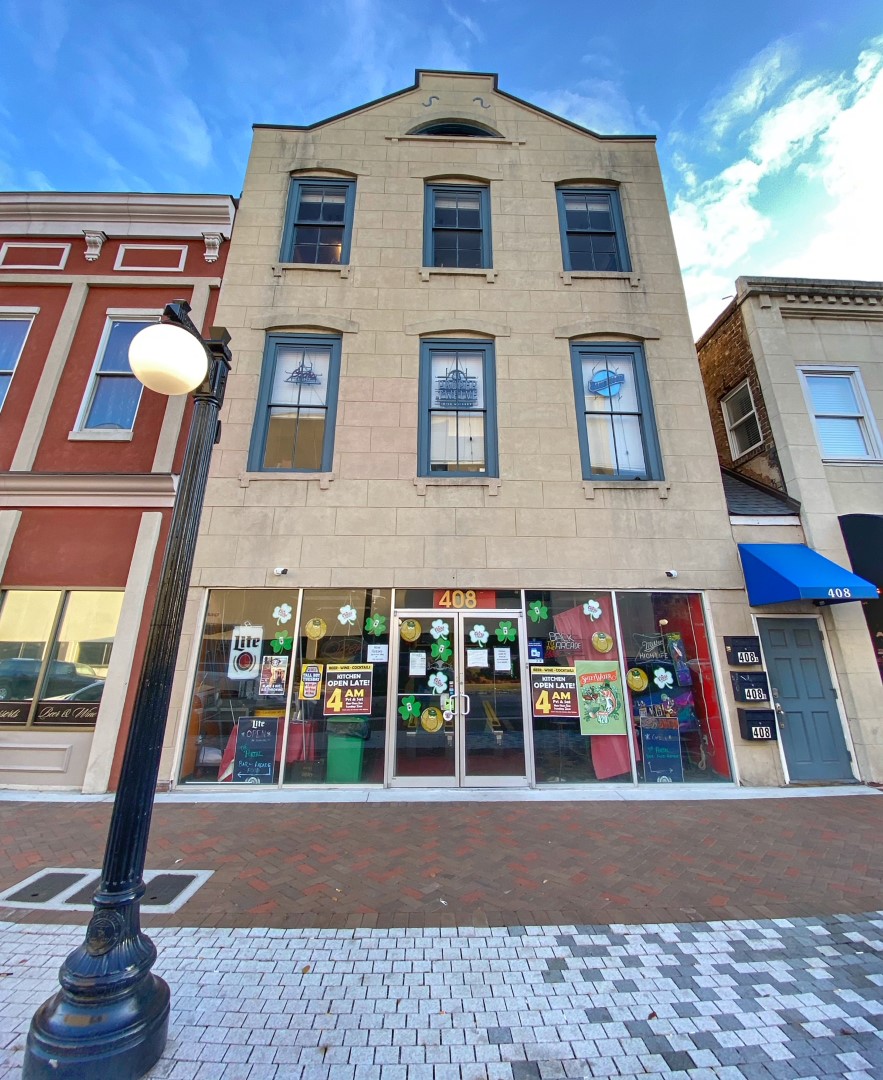 408 West Broughton Street (1860) where John Walz was boarder in 1898.
408 West Broughton Street (1860) where John Walz was boarder in 1898.
Walz was a boarder at 507 East Broughton Street from 1902 through 1907.
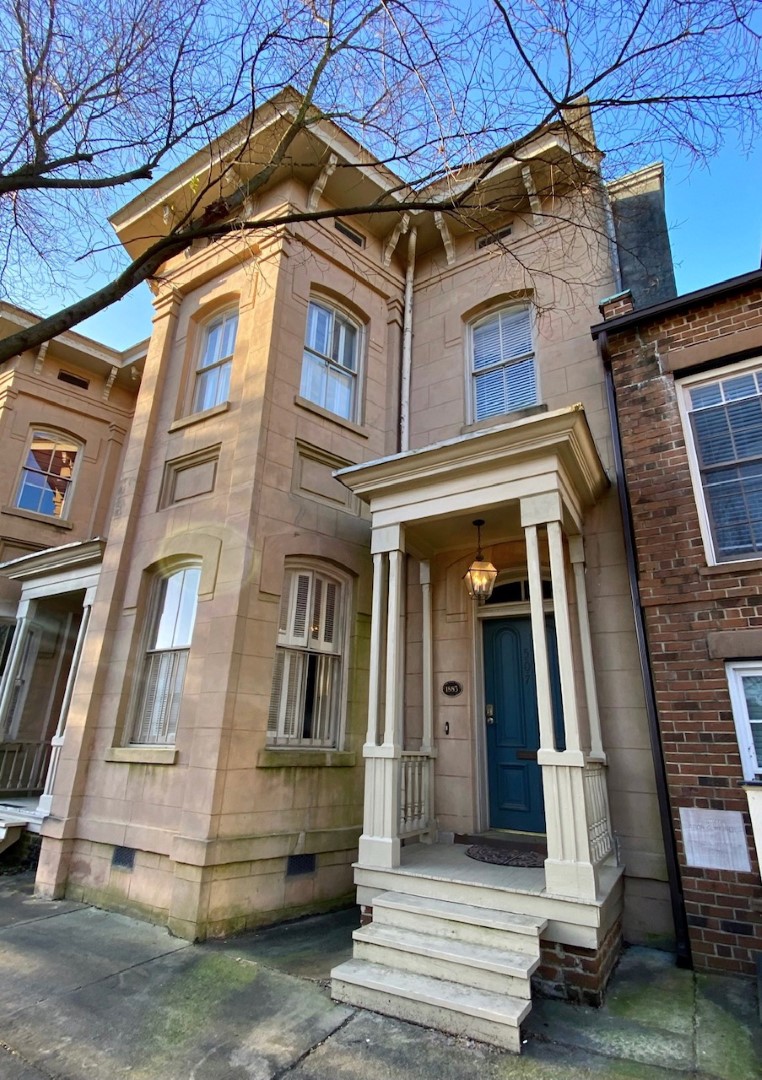 507 East Broughton Street (1883). P Marlin 2021
507 East Broughton Street (1883). P Marlin 2021
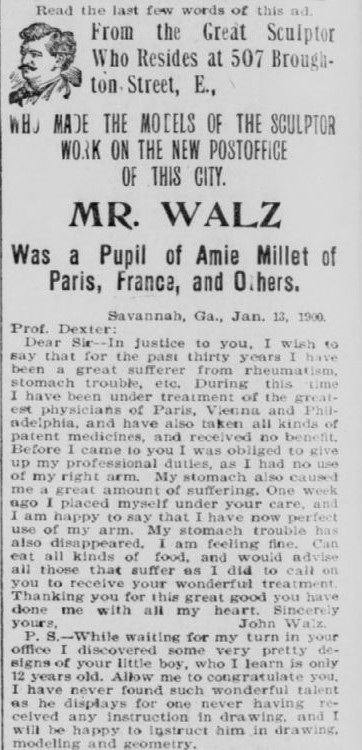 John Walz touting a product in
The Morning News on January 16, 1900.
John Walz touting a product in
The Morning News on January 16, 1900.
This 1916 Sanborn map shows Walz's stone cutting area located behind 409 East Liberty Street. He lived and worked here from 1912 through 1922.
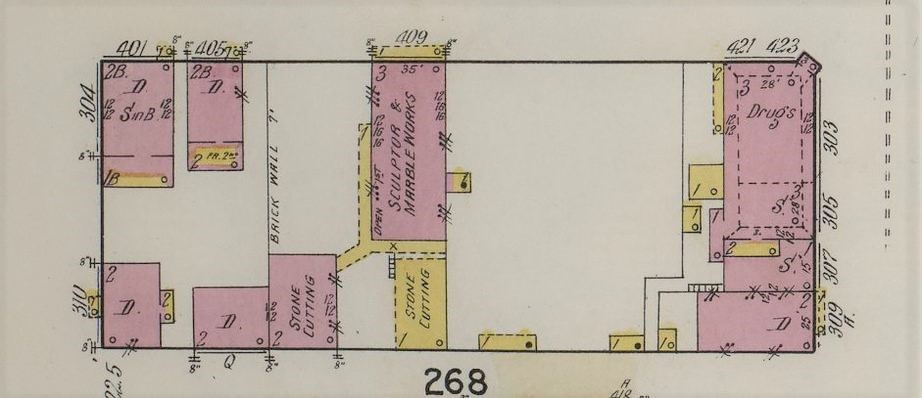 1916 Sanborn map of 407-409 East Liberty Street, Savannah, Georgia. Library of Congress
1916 Sanborn map of 407-409 East Liberty Street, Savannah, Georgia. Library of Congress
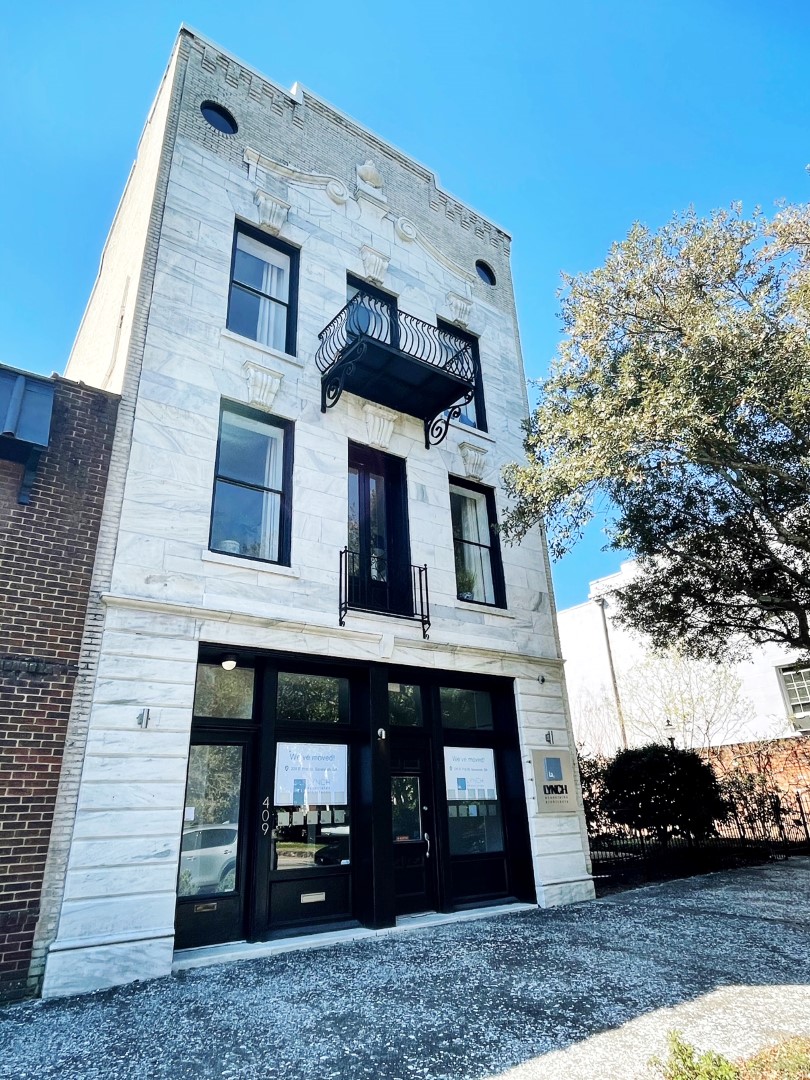 409 East Liberty Street where John Walz lived and had his studio from 1912 until he died in 1922. Notice the decor added to the front of the building by Walz. (1900). P Marlin 2021
409 East Liberty Street where John Walz lived and had his studio from 1912 until he died in 1922. Notice the decor added to the front of the building by Walz. (1900). P Marlin 2021
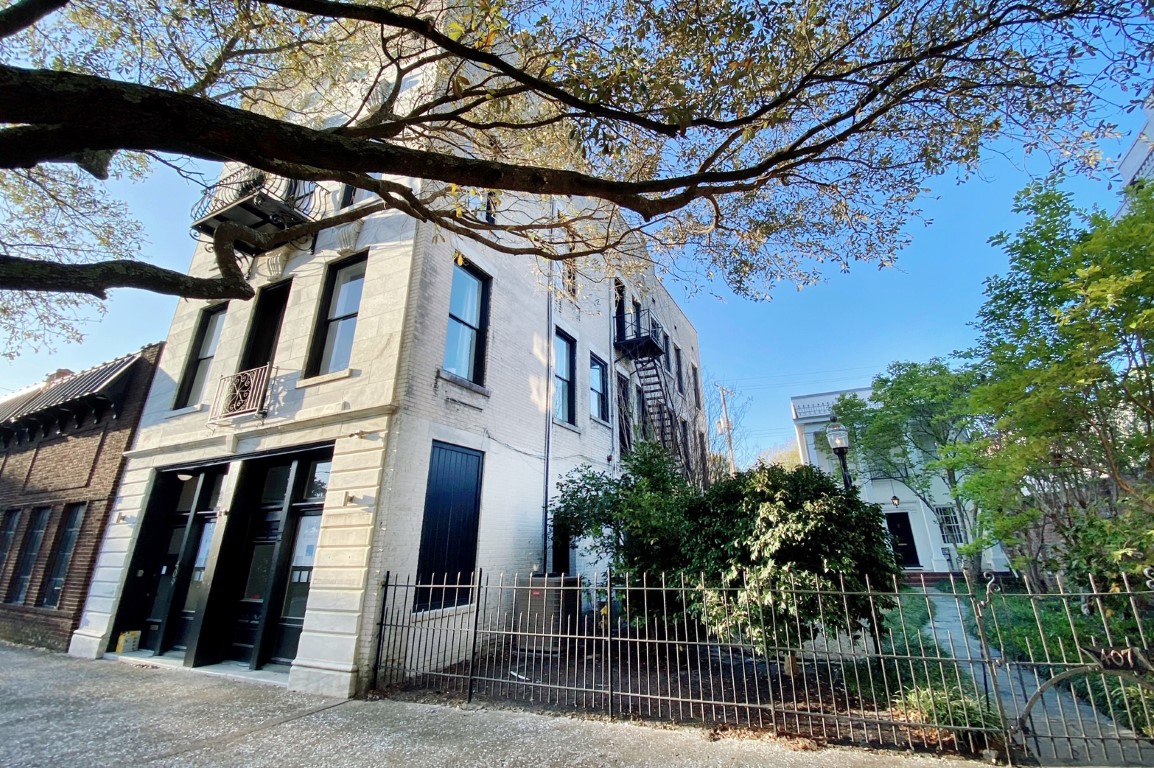 The yellow house that sits back from the road is 409 East Liberty.
According to the Sanborn map, Walz's stone cutting shop was located where the house is located today.
The house was not built until 1930, so Walz never lived in it. P Marlin 2021
The yellow house that sits back from the road is 409 East Liberty.
According to the Sanborn map, Walz's stone cutting shop was located where the house is located today.
The house was not built until 1930, so Walz never lived in it. P Marlin 2021
When Walz died in 1922, he was buried in his wife’s plot in Bonaventure. Ironically, Walz did not have his own headstone until one was commissioned for him by the Bonaventure Historical Society. Obituary
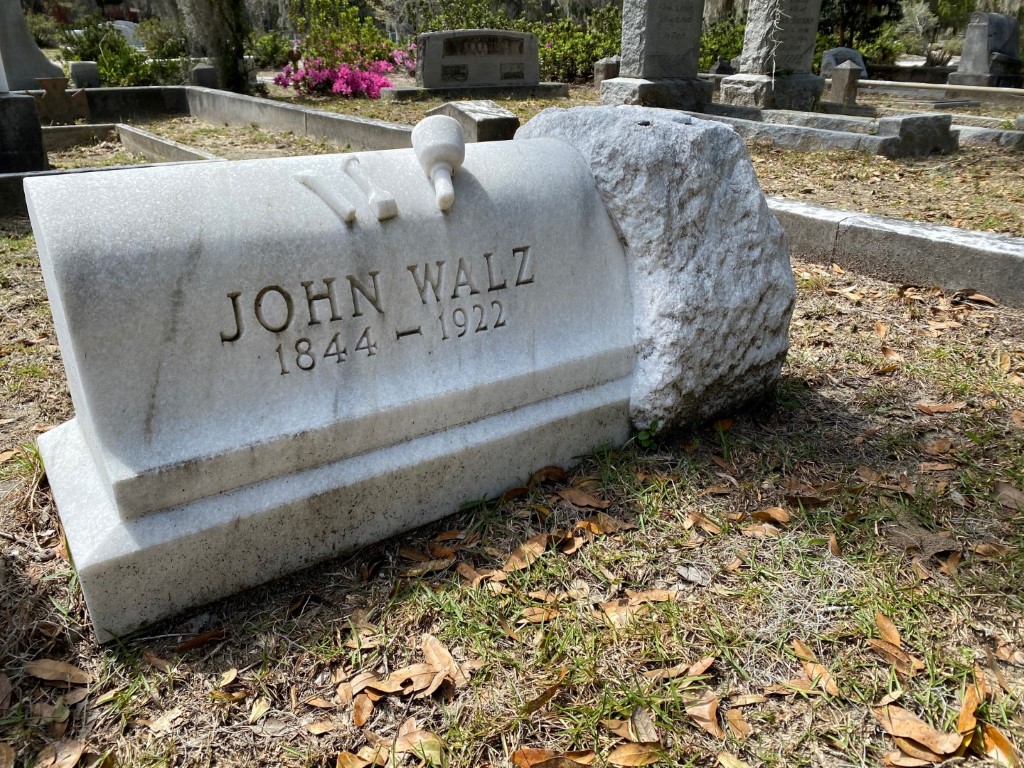 John Walz. P Marlin 2021
John Walz. P Marlin 2021
Bonventure's beautiful "sculpture garden" is difficult to imagine without Walz's contributions. The search for Walz's funerary art reveals a consistent style. Common to his style were the "cradle graves" that were popular in the Victorian Era. Cradle graves have both a headstone and a footstone connected by two low walls. Typically these graves were used to plant flowers. Walz's style is identified on the unique cradle grave footstones where the deceased's initials are intricately carved. Concerned that his style would be imitated, Walz copyrighted some of his creations.
Unfortunately, Walz's signature is difficult to find on aged monuments. The Bonaventure Historical Society assisted my sculptor search by providing a list titled "Marked sculptures by various sculptors in Bonaventure Cemetery, sections A-K." 9
The Honoria S. Foley cradle grave was sculpted by Walz. Honoria was married to Charles Molony at the Cathedral of St. John the Baptist on February 18, 1903 . After the honeymoon, the couple lived at 124 Jones Street East in Savannah. Honoria died four years later at twenty-eight years old. Walz also created a cradle grave for Honoria's brother, Frank, who died at four years old. Frank's grave is located behind Honoria's. Both Honoria and Frank have their mother's name, Susie T. Martin, engraved on their headstone. According to the sculptor list from Bonaventure Historical Society, both Frank and Honoria were re-interred at Bonaventure in 1908 meaning they were moved from another cemetery.
Honoria and Frank Foley's cradle grave footstones with carved initials are a classic example of Walz's work. Honoria's headstone is adorned with Easter lilies and lily of the valley, both symbolize innocence and purity. The lily of the valley is also significant as the first flower to bloom in spring, symbolizing renewal and resurrection. Morning glory is a symbol of the Resurrection, because the flower closes at night and opens in the morning sun. Look for Walz's signature on Honoria's footstone and the front of Frank's headstone.
 Honoria S. Foley Monolony. P Marlin 2021
Honoria S. Foley Monolony. P Marlin 2021
 Honoria and Frank Foley. P Marlin 2021
Honoria and Frank Foley. P Marlin 2021
 Frank Foley. P Marlin 2021
Frank Foley. P Marlin 2021
The Diedrich and Margaret Downey Grimm monument was sculpted by John Walz. The sculpted angel writing on a tablet may signify writing down the good deeds of the deceased, or writing their name in the Book of Life. Angels are guardians of God; they guard the tomb, guide the soul, and direct the living visitor to think heavenward. The complete columns on either side represent a full life. This sculpture is one of many Walz created for his fellow German immigrants.
Born in Germany, Diedrich Grimm was a grocer and saloon owner in Savannah. According to Ancestry's records, he received his liquor license in 1886 and, in additional court documents, was fined $50.00 for keeping his saloon (bar room) open on a Sunday (April 29, 1888).
 Grimm. P Marlin 2021
Grimm. P Marlin 2021
Mary Sneed Remshart's cradle grave (located on the right) was sculpted by Walz. Note the initials carved on the footstone and the carved Easter lilies on the headstone signifying purity and innocence. Mary was a native of Savannah and married William Wallace Remshart (monument left - unknown sculptor) who preceeded her in death. Mary died of heart failure. Obituary.
 Mary Sneed Remshart. P Marlin 2021
Mary Sneed Remshart. P Marlin 2021
This beautiful sculpture was created by Walz for George Dieter and his wife, Catherine Sophia Ruedenauer Dieter. According to George Dieter's obituary, he arrived in Savannah in 1954 from Wittenburg, Germany. Dieter worked for Morel Furniture Company before going into the sausage business. He was active with his fellow Germans from Savannah. He died of Brights Disease. Obituary.
 Dieter. P Marlin 2021.
Dieter. P Marlin 2021.
In the photo below, Walz's signature is barely visible on the front right of George Dieter's tomb and the front left of Catherine's. The engraved acorns on George's tomb symbolize prosperity and the oak leaves signify many things including, strength, endurance, liberty, faith and virtue. Catherine's roses are typical for a woman's grave. The openness of a rose can signify the age of the deceased, with a fully open rose signifying an older woman.
 Dieter. P Marlin 2021.
Dieter. P Marlin 2021.
This plot includes two children's cradle graves, Mary and John Schwarz. The Victorian cherub face was a symbol of innocence and immortality and were typical for children's graves. The unopened rose on the top of the initialed footstone represents a child who did not get the chance to "bloom." Walz's signature is visible on the front right of John Schwarz's grave.
 Mary Scharwz and John N. G. Schwarz.
P Marlin 2021
Mary Scharwz and John N. G. Schwarz.
P Marlin 2021
The Gertrude A. Bliss McMillan sculpture by John Walz. According to Georgia Vital Records, Gertrude died of septicemia after a duration of 48 hours (Record). Obituary Also located on this plot is a headstone created by Walz for the Wheless children. Located to the left of Gertrude, Walz's signature is visible on the left above the "W" in the photo below.
 Gertrude A. Bliss McMillan. P Marlin 2021.
Gertrude A. Bliss McMillan. P Marlin 2021.
 A close up of Walz's signature. P Marlin 2021.
A close up of Walz's signature. P Marlin 2021.
 Julia Catherine Wheless
and Pearce R. Wheless Jr. P Marlin 2021
Julia Catherine Wheless
and Pearce R. Wheless Jr. P Marlin 2021
John A. Schafer sculpture by John Walz. Born in Wurttemberg, Germany, John Schafer is credited with building nearly all the cotton gins in Georgia, Alabama, and Florida prior to the Civil War. Obituary - A Former Savannahian dead. This is the only treestone in Bonaventure. The treestone was part of a Victorian rusticity movement popular from 1880 to 1905. Located on the treestone are a palm frond symbolizing victory, an hourglass with wings, symbolizing time flies, a fern symbolizing humility, frankness and sincerity, and a drape, seen as a reverential accessory or as a symbol of a veil between earth and heaven. Walz's sculpture signature lists Philadephia and Savannah.
 John A. Schafer. P Marlin 2021
John A. Schafer. P Marlin 2021
 John A. Schafer. P Marlin 2021
John A. Schafer. P Marlin 2021
Gracie Watson sculpture by Walz. Gracie's sculpture is unique in how closely it resembles Gracie herself. Made from a picture Gracie's father gave to Walz, the details of the sculpture include the button detail on her dress and button up shoes. Her hands seems to hold an unopened rose signifying a life that did not bloom. Gracie died at Easter time. April 23, 1889.
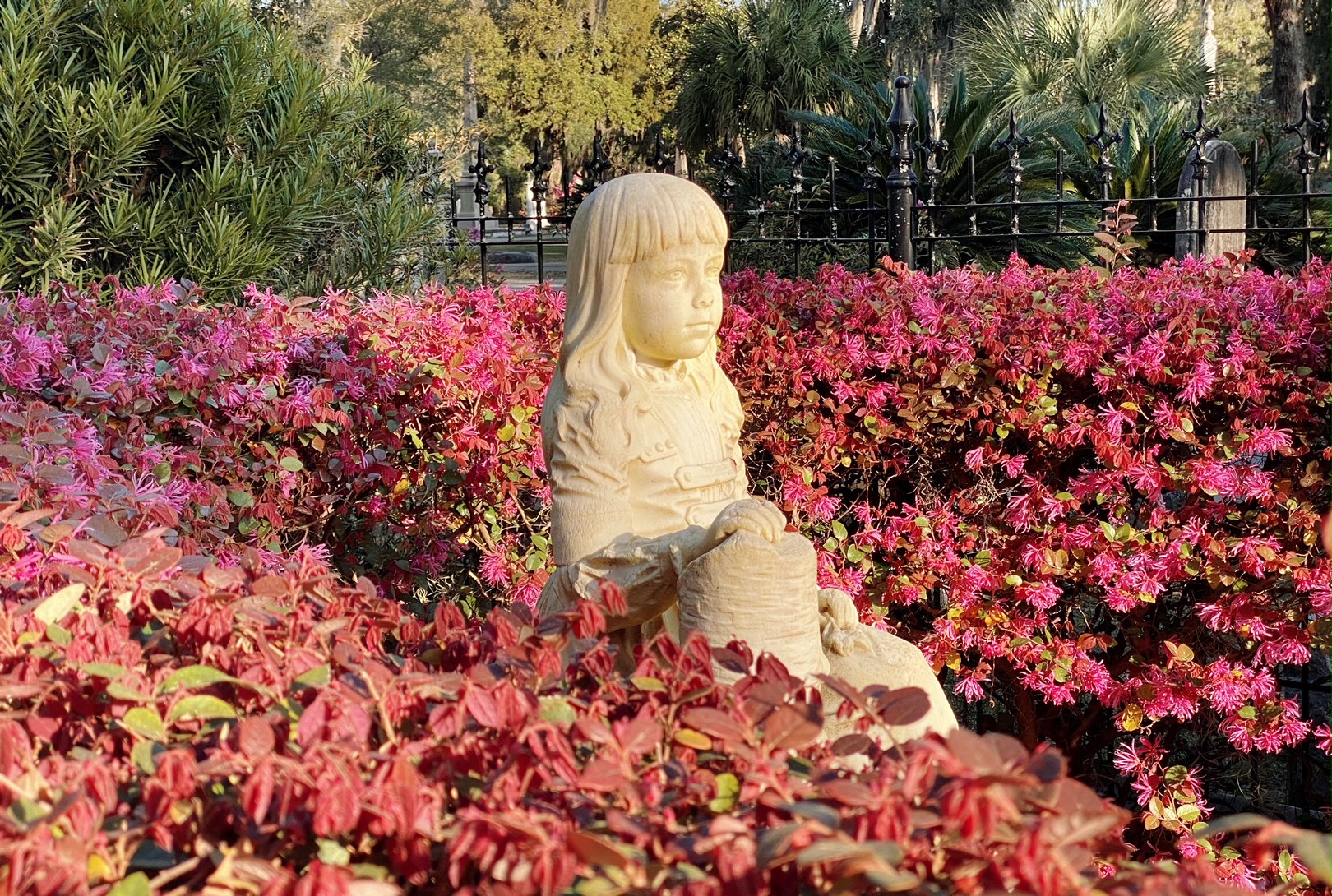 Gracie Watson. P Marlin 2021
Gracie Watson. P Marlin 2021
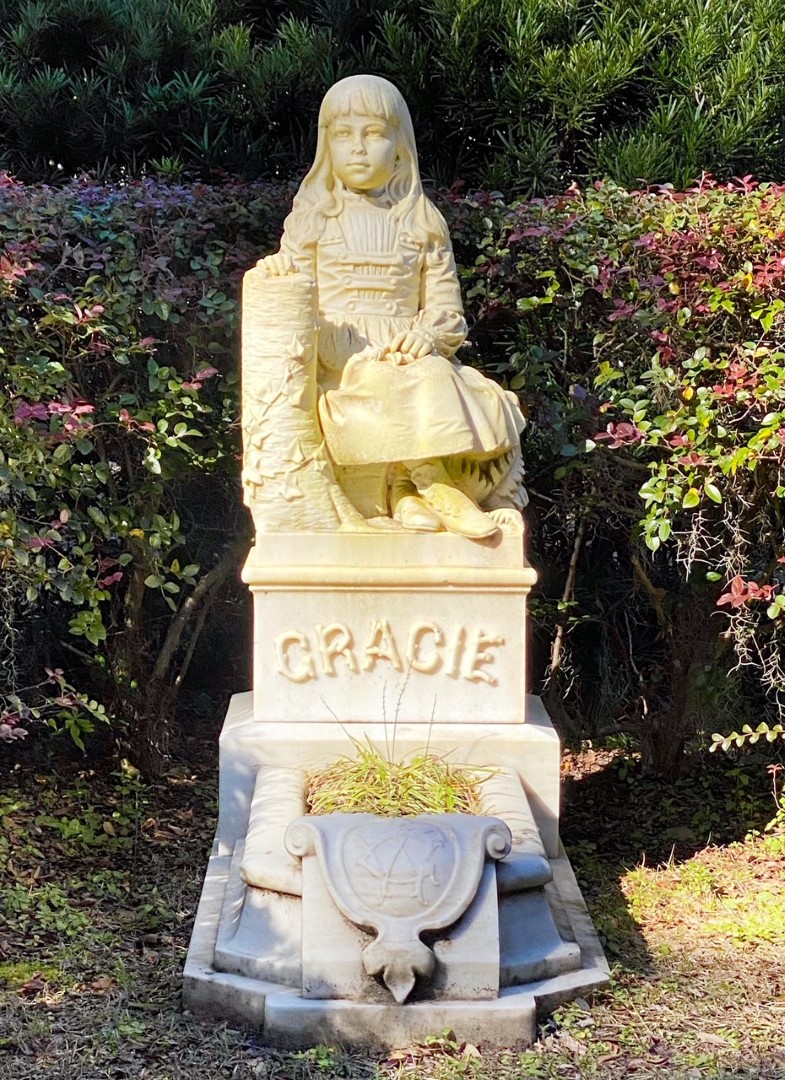 Gracie Watson. P Marlin 2021
Gracie Watson. P Marlin 2021
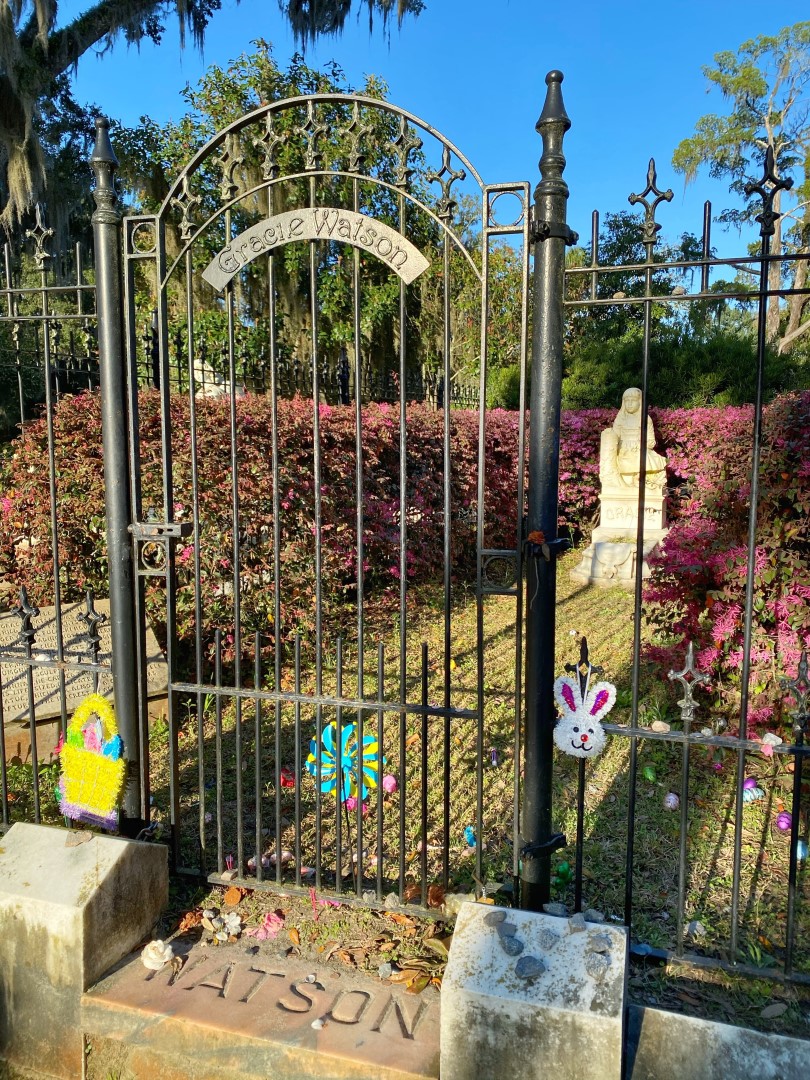 The Gracie Watson gravesite decorated for Easter.
P Marlin 2021
The Gracie Watson gravesite decorated for Easter.
P Marlin 2021
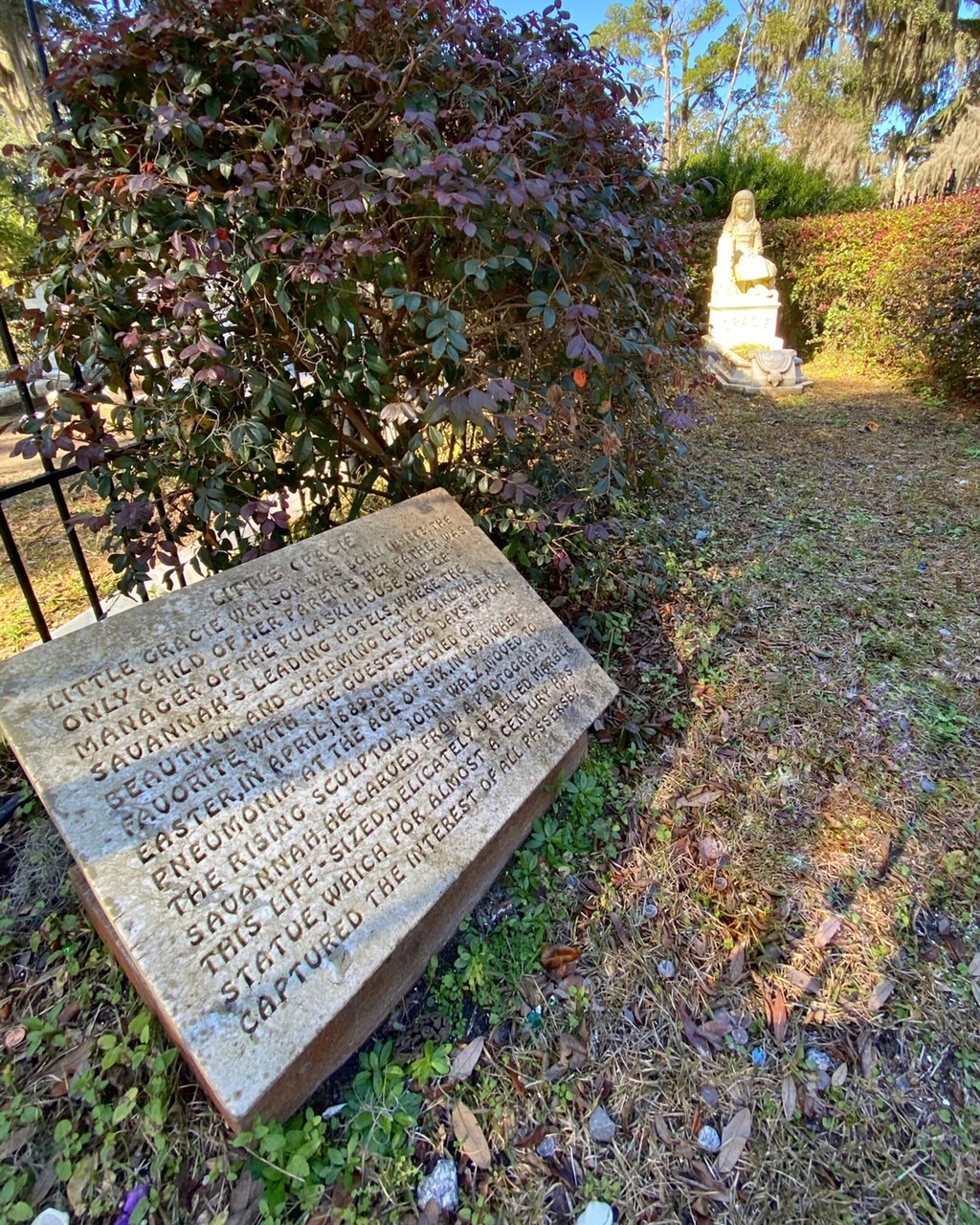 "Little Gracie Watson was born in 1882, the only
child of her parents, her father was manager
of the Pulaski House, one of Savannah's leading hotels,
where the beautiful and charming little girl was
a favorite witht the guests. Two days before Easter,
in April 1889, Gracie died of pneumonia at the age of six.
In 1890, when the rising sculptor, John Walz, moved
to Savannah, he carved from a photograph this life-sized,
delicately detailed marble statue, which for almost
a century has captured the interest of all passersby." P Marlin 2021
"Little Gracie Watson was born in 1882, the only
child of her parents, her father was manager
of the Pulaski House, one of Savannah's leading hotels,
where the beautiful and charming little girl was
a favorite witht the guests. Two days before Easter,
in April 1889, Gracie died of pneumonia at the age of six.
In 1890, when the rising sculptor, John Walz, moved
to Savannah, he carved from a photograph this life-sized,
delicately detailed marble statue, which for almost
a century has captured the interest of all passersby." P Marlin 2021
Andrew Hunting Granger tomb sculpted by Walz. Little Andrew died at 17 months old after a brief illness. The Victorian cherubs symbolize innocence and immortality and was typical for children's graves. Obituary
 Andrew Hunting Granger. P Marlin 2021
Andrew Hunting Granger. P Marlin 2021
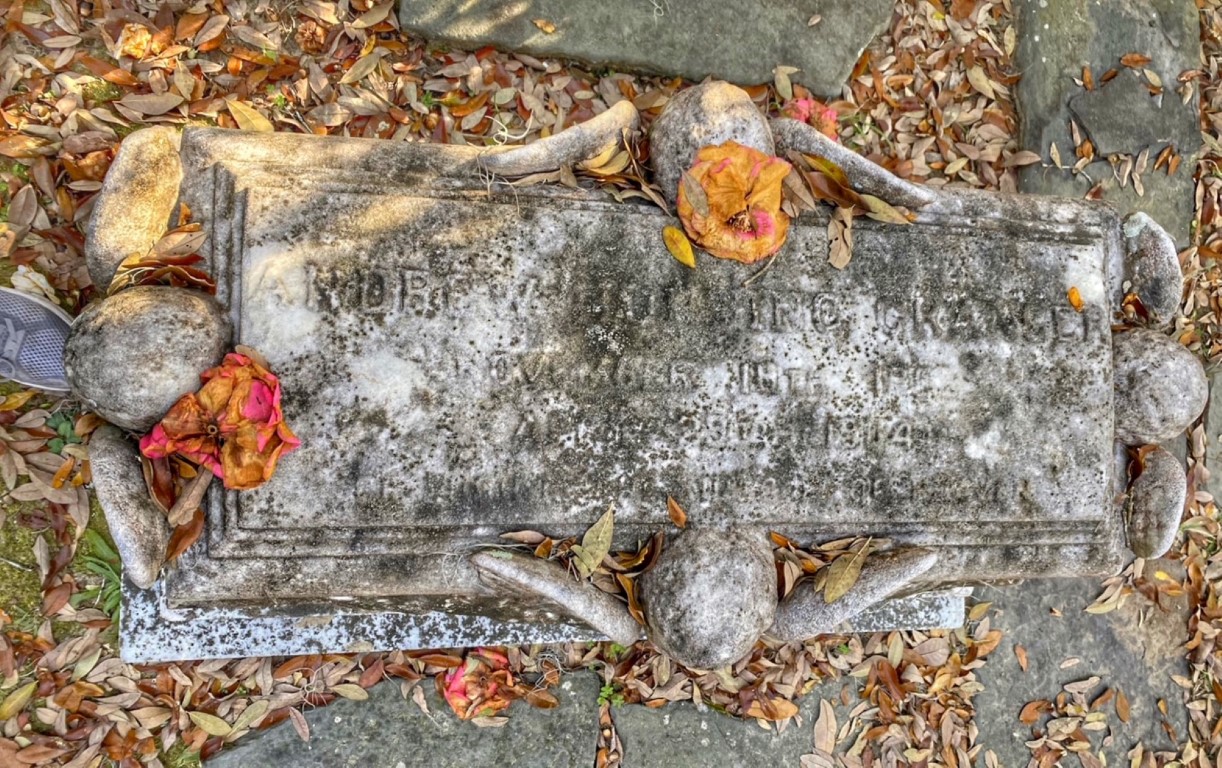 Top view of Andrew Hunting Granger. P Marlin 2021
Top view of Andrew Hunting Granger. P Marlin 2021
Barbara Ruckert and Louise Ruckert cradle grave sculpted by Walz. Barbara Ruckert, Joseph's first wife, was born in Germany. Ruckert's second wife, Louisa, died in 1893 (age 54) after an illness of seven weeks. An 1899 Savannah News article mentions that F. Joseph Ruckert had returned to Germany, though it is not known if it was a permanent move. Each of Ruckert's wives has a first initial engraved on the base of the urns on either side of the headstone. The headstone's sculpted angel is holding a palm symbolizing victory or triumph over death. The footstone has initials, though I cannot tell which wife they belong to. There is a partially opened rose on the footstone possibly signifying a woman of middle age. The Easter lily symbolizes innocence and purity. Walz's signature is on the bottom right of the headstone. Obituary for Louisa .
 Wives of F. Joseph Ruckert. P Marlin 2021
Wives of F. Joseph Ruckert. P Marlin 2021
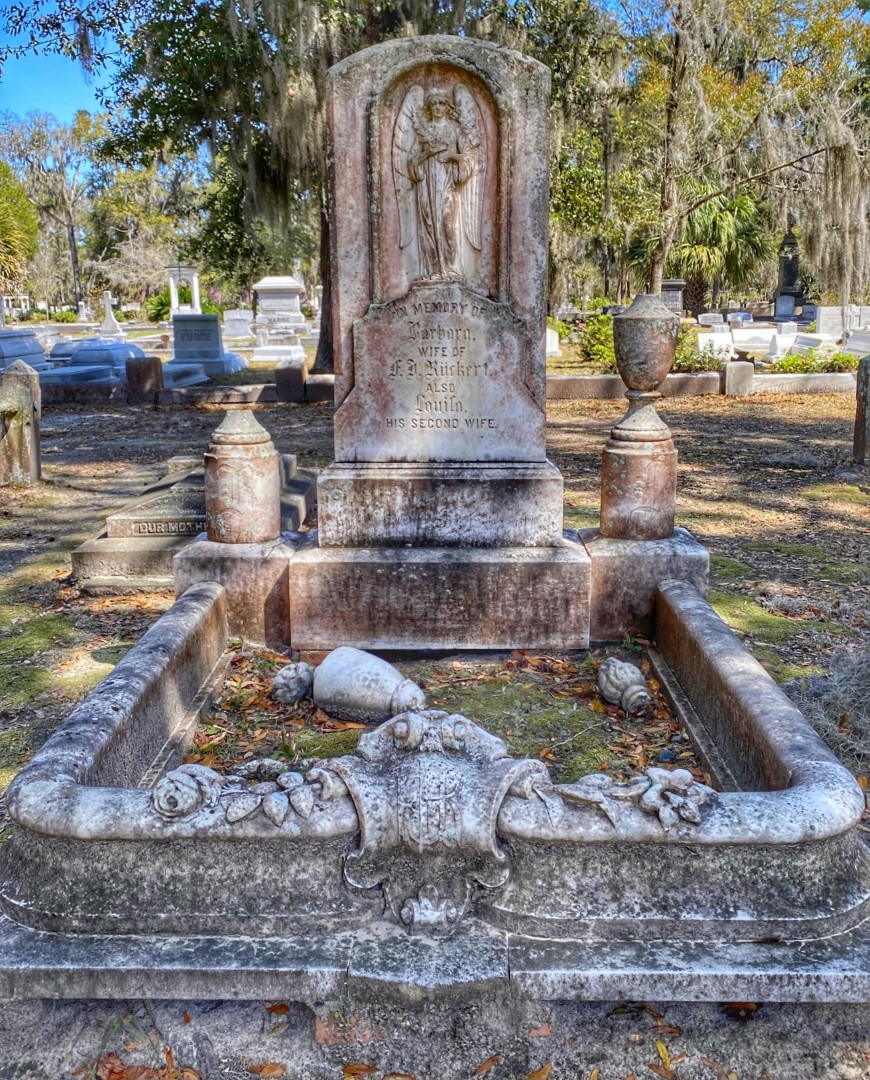 Wives of F. Joseph Ruckert. P Marlin 2021
Wives of F. Joseph Ruckert. P Marlin 2021
Dorothy Miles Wilcox tomb sculpted by Walz. Little Dorothy died two days before Christmas at only 8 months old.
 Dorothy Miles Wilcox. P Marlin 2021
Dorothy Miles Wilcox. P Marlin 2021
 Dorothy Miles Wilcox. P Marlin 2021
Dorothy Miles Wilcox. P Marlin 2021
Joseph and Clara Herschbach headstone by Walz. Both Joseph and Clara were born in Germany. Joseph had a large cigar-manufacturing house in Savannah. Clara died of pneumonia a year before her husband Joseph died. They lived at 314 Oglethorpe Avenue. Created in the Grecian style, a 1907 article described the headstone as "The angel is carved in repose, with bowed head and a divine expression, to which the clouds and architecture as a background add harmoniously." In funerary art, the crown symbolizes the sovereignty of the Lord. 8 Walz's signature is visible under "Father."
 Joseph and Clara Goebel Herschbach. P Marlin 2021
Joseph and Clara Goebel Herschbach. P Marlin 2021
Peter and Mary Schafer cradle grave by Walz. Peter Schafer was born in Germany and upon arrival in Savannah, was listed as a baker in the 1870 and 1880 census. On April 20th, 1872, Peter was in violation of a city ordinance by hitching his horse to a tree on Habersham Street, he was fined $2.00. Peter died in Suwanee Springs, Florida after a long illness and was removed to Savannah for burial. Notice the footstone typical of Walz's work. The carved angel, holding lilies symbolizing innocence and purity, seems to be ascending into Heaven. This particular design was copyrighted by Walz. Obituary
 Peter and Mary
Schafer. P Marlin 2021
Peter and Mary
Schafer. P Marlin 2021
 Peter and Mary
Schafer design copyrighted by Walz. P Marlin 2021
Peter and Mary
Schafer design copyrighted by Walz. P Marlin 2021
John F. Krenson monument sculpted by John Walz. John Krenson died during the Civil War in Richmond, Virginia, where he had received a battle wound. He was originally interred at Laurel Grove Cemetery, then re-interred at Bonaventure. The urn is symbolic of a body that has decayed and turned to dust, while the spirit of the departed eternally rests with God. The drape can be either a reverential accessory or a symbol of the veil between earth and heaven. Obituary
 John F. Krenson. P
Marlin 2021
John F. Krenson. P
Marlin 2021
James and Elizabeth Foster sculpted by Walz. The urn is symbolic of a body that has decayed and turned to dust, while the spirit of the departed eternally rests with God. The complete columns represent a full life and pillar of the community.
 James and Elizabeth Foster.
P Marlin 2021
James and Elizabeth Foster.
P Marlin 2021
Mary Ellen Rogers cradle grave sculpted by Walz. Note the initials carved on the footstone and the carved Easter lilies on the headstone signifying purity and innocence.
 Mary Ellen Rogers. P Marlin 2021
Mary Ellen Rogers. P Marlin 2021
 Mary Ellen Rogers. P Marlin 2021
Mary Ellen Rogers. P Marlin 2021
In addition to John Walz, many sculptors have contributed to Bonaventure's funerary art. Some of these include R. D. Walk, P Reinhalter & Co., G.B. Little, and Italian sculptors. These are listed in Bonaventure Historical Society's list of sculptors (excluding Walz). 9
"Robert D. Walker opened his Marble and Stone works in Savannah in 1840 and remained in business until the end of the 19th century. Beginning in the 1850s, Walker’s stone yard was located on the block of York Street currently occupied by the Jepson Center. In 1900, Walker sold out to another stone yard owner, Irish-born Patrick Hagan, whose work is also found at Bonaventure." 12 In addition to his works in Savannah's Catholic and Laurel Grove Cemeteries , Walker has many funerary art pieces in Bonaventure including Minna Holcombe and Martin Menges seen below.
 Minna Holcombe. P Marlin 2021
Minna Holcombe. P Marlin 2021
 Minna Holcombe. P Marlin 2021
Minna Holcombe. P Marlin 2021
 Signature of Walker
on the base of the Minna Holcombe monument. P Marlin 2021
Signature of Walker
on the base of the Minna Holcombe monument. P Marlin 2021
 Martin Menges. P Marlin 2021
Martin Menges. P Marlin 2021
Benedetto Civiletti was an Italian 19th Century artist based in Palermo, Sicily who sculpted the Corinne Elliott Lawton monument. Notice the laurel wreath symbolizing victory, eternity, immortality and chastity. The leaves represent victory and immortality since they do not wilt or fade. Corinne's monument was originally at Laurel Grove cemetery before being moved to Bonaventure.
 Corinne Elliot Lawton (Civiletti signature on bottom right).
P Marlin 2021
Corinne Elliot Lawton (Civiletti signature on bottom right).
P Marlin 2021
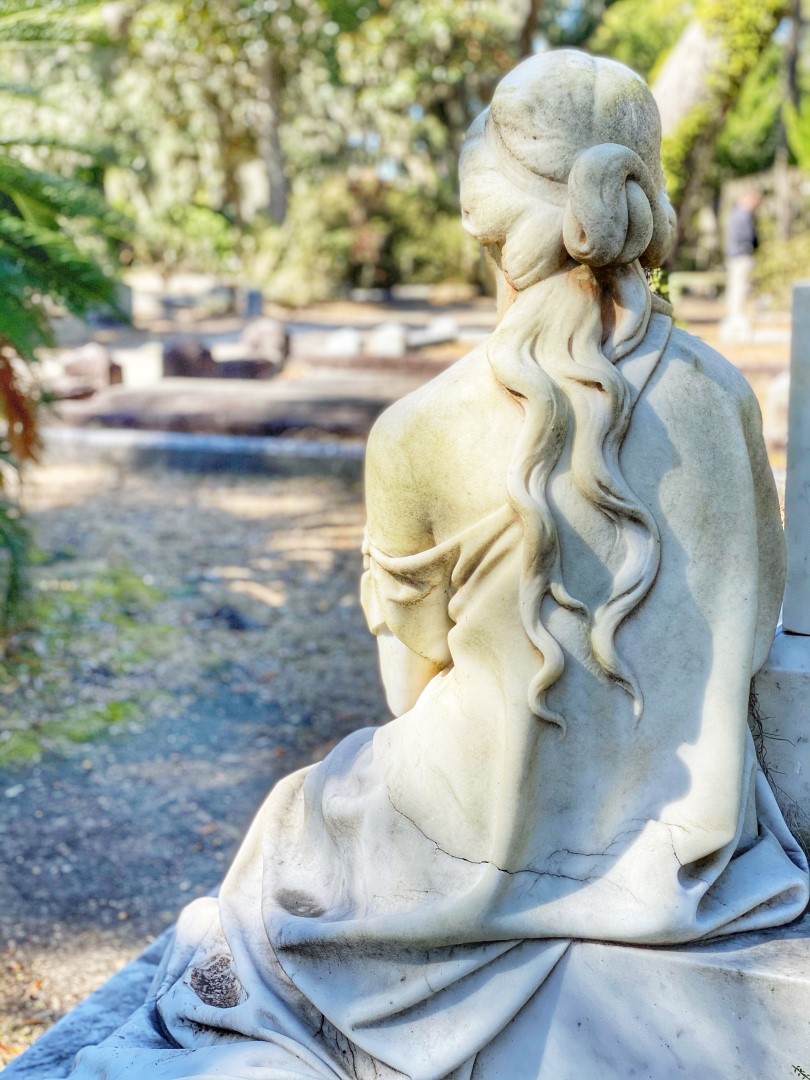 Corinne Elliot Lawton. P Marlin 2021
Corinne Elliot Lawton. P Marlin 2021
Raffaello Romanelli was born in Florence in 1856. He attended, and then became professor at the Academy of Fine Arts in Florence. Romanelli sculpted the Lawton family monument where Alexander Robert and Sarah Lawton are buried.
 Alexander Robert and Sarah Lawton. P Marlin 2021
Alexander Robert and Sarah Lawton. P Marlin 2021
"Oglethorpe Marble and Granite Company, Savannah’s longest operating marble yard and monument company, was established in 1907 by G.B. Little, Sr., who moved to Savannah from Charleston in 1898. Little bought out several other stone companies by 1912 and furnished monuments for many of the city’s cemeteries, including Bonaventure. His son, Milton J. Little, trained early as a stonecutter and completed his first monument at the age of 11. He continued the business after G.B.’s death, producing countless markers for cemeteries throughout Savannah as well as other public works such as the 1947 Marine Monument in Forsyth Park. Milton’s daughter Virginia and son-in-law Dan Mobley represent the third generation to manage Oglethorpe Marble and Granite Company, which still produces monuments for Savannah’s cemeteries today, in the same location on East Broad Street where it has operated since 1927." 12
This is one of my favorite pieces of funerary art in Bonaventure. Oglethorpe Marble and Granite Company confirmed it was the work of G.B Little.
 Theodore Prendergast. P Marlin 2021
Theodore Prendergast. P Marlin 2021
 Theodore Prendergast. P Marlin 2021
Theodore Prendergast. P Marlin 2021
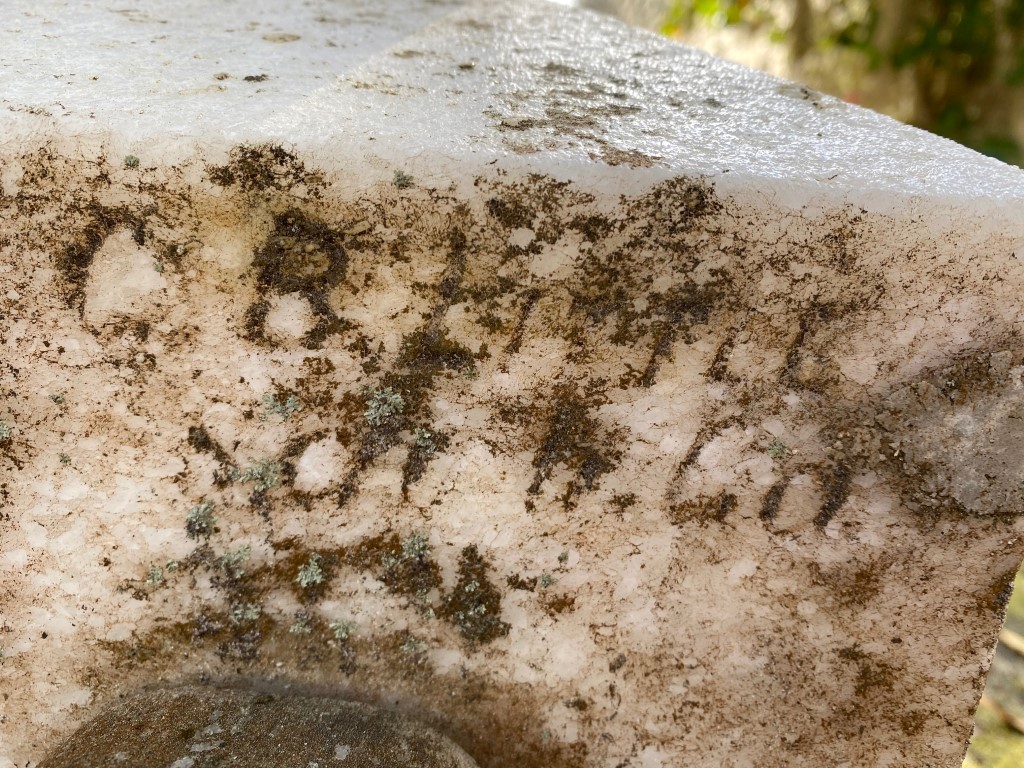 Signature of G.B. Little, Sav & Co., P Marlin 2021
Signature of G.B. Little, Sav & Co., P Marlin 2021
P. Reinhalter & Co. was located in Philadelphia, Pennsylvania. Examples of their work include the Charles and Ernestine Seiler and the Marie M. Barclay Tailiaferro sculptures seen below.
 Charles and Ernestine Seiler. P Marlin 2021
Charles and Ernestine Seiler. P Marlin 2021
 Marie M. Barclay Tailiaferro. The angel lays
the palm frond symbolizing victory over death. P Marlin 2021
Marie M. Barclay Tailiaferro. The angel lays
the palm frond symbolizing victory over death. P Marlin 2021
 Marie M. Barclay Tailiaferro. P Marlin 2021
Marie M. Barclay Tailiaferro. P Marlin 2021
Aliffi was born in Italy, the son and grandson of sculptors. Aliffi traveled to Savannah to work for Walz, and like Walz, his work can be seen in several of Savannah's early buildings. Aliffi worked on many of Walz's monuments in Bonaventure, however, since Walz was Aliffi's employer, Walz's name is signed to them. Aliffi is credited with creating the Orsini monument below. Aliffi also worked on Georgia's Stone Mountain as well as Mount Rushmore. 8
 Sebastiano Orsini. P Marlin 2021
Sebastiano Orsini. P Marlin 2021
 Sebastiano Orsini. P Marlin 2021
Sebastiano Orsini. P Marlin 2021
Charles S. Arnold headstone and footstone created by R. Barry of Boston, Massachusetts.
 Charles S. Arnold P Marlin 2021
Charles S. Arnold P Marlin 2021
Photos of funerary art by unknown sculptors.
 Colonel Aaron Wilbur. P Marlin 2021
Colonel Aaron Wilbur. P Marlin 2021
 Ernst A.Martin and Minna Schroder were both from Germany.
Earnst was alderman and director of the National Bank of Savannah. P Marlin 2021
Ernst A.Martin and Minna Schroder were both from Germany.
Earnst was alderman and director of the National Bank of Savannah. P Marlin 2021
 The Thomas and Eliza Theus monument as seen through the
Ives monument. Thomas
Nichol Theus was a jeweler and devoted Confederate soldier.
Obituary P Marlin 2021
The Thomas and Eliza Theus monument as seen through the
Ives monument. Thomas
Nichol Theus was a jeweler and devoted Confederate soldier.
Obituary P Marlin 2021
 The Thomas and Eliza Theus monument. Thomas
Nichol Theus was a jeweler and devoted Confederate soldier.
Obituary. P Marlin 2021
The Thomas and Eliza Theus monument. Thomas
Nichol Theus was a jeweler and devoted Confederate soldier.
Obituary. P Marlin 2021
 Baldwin family monument. P Marlin 2021
Baldwin family monument. P Marlin 2021
 P Marlin 2021
P Marlin 2021
 P Marlin 2021
P Marlin 2021
 Bacon family monument. P Marlin 2021
Bacon family monument. P Marlin 2021
 Nancy Herndon Mercer. P Marlin 2021
Nancy Herndon Mercer. P Marlin 2021
 Lillian Elizabeth Mercer, mother of Johnny Mercer. P Marlin 2021
Lillian Elizabeth Mercer, mother of Johnny Mercer. P Marlin 2021
 Mary Adele Slater, infant. P Marlin 2021
Mary Adele Slater, infant. P Marlin 2021
 MacPherson M. Rogers. Sadly, one of three brothers to all die fairly young. MacPherson is in the same plot as his parents and
brother, William (next photo). Obituary P Marlin 2021
MacPherson M. Rogers. Sadly, one of three brothers to all die fairly young. MacPherson is in the same plot as his parents and
brother, William (next photo). Obituary P Marlin 2021
 William Rogers. Sadly, one of three brothers to all die fairly young. William is in the same plot as his parents and
brother, MacPherson (above photo). Obituary P Marlin 2021
William Rogers. Sadly, one of three brothers to all die fairly young. William is in the same plot as his parents and
brother, MacPherson (above photo). Obituary P Marlin 2021
 Paulsen babies. P Marlin 2021
Paulsen babies. P Marlin 2021
 Emma Preston Roberts Walthour. P Marlin 2021
Emma Preston Roberts Walthour. P Marlin 2021
 McMillan and Wheless plot. P Marlin 2021
McMillan and Wheless plot. P Marlin 2021
 William Walter, infant. P Marlin 2021
William Walter, infant. P Marlin 2021
 P Marlin 2021
P Marlin 2021
 P Marlin 2021
P Marlin 2021
1 National Register of Historic Places
3 Bonaventure Historical Society
4 Bonaventure A Historical Sketch
8 Images of American Historic Bonaventure Cemetery
9 Marked Sculptures by various sculptors in Bonaventure Cemetery. Bonaventure Historical Society
12 Monument Makers of Bonaventure Cemetery Telfair Museums